#Mango Power Union
Explore tagged Tumblr posts
Text
EcoFlow Alternatives: The Best Alternative Places to Buy Portable and Home-Friendly Power Backup Systems
EcoFlow is a top player in the global market for portable and home power stations. The brand offers a wide range of solar battery packs, starting from a 256 Wh entry-level River 2 for extreme portability to a huge 3.6–25 kWh Delta Pro home battery for seamless backup power. In between, there are around a dozen incredible power stations of various capacities and sizes, and the brand also offers…

View On WordPress
0 notes
Text
Sakal Ban
Oh look how the streets have been adorned with colourful banners and flower boughs. The flags of my kingdom fly high on the beautiful carved towers, showing the grandeur of my city.
It's the time of the Spring festival. The fields look as golden as the sun with mustard flowers sprouting from the brown soil, their slender stalks flowing in the flower-laden spring breeze, and maidens wearing colourful robes with chiming anklets on soft red-dyed feet run through the golden fields.
I used to be one of them ages ago. These young girls donned in light shaded robes look as beautiful blooms of the royal garden, which used to be a place for my secret trysts with the handsome young lover, who is still elegant and regal as ever, but alas, no longer mine.
Mango buds hang from the branches, and little children play with stones and pebbles under the young tree. Somewhere in the distance, in the extravagant places of the courtly dancers and musicians, I see a lovely maiden adorn flowers in her braid.
Oh, honeybees, you traverse in circles
around the lone nectar-filled bloom in vain.
When you have the whole garden behind her head
Why go for the single little flower of a shrub?
I make my way through the crowded colourful streets once again like I do every Spring Festival, every year and pay my respects at the Nizamudin's shrine.
Dusty paths permeate with a fragrance of jasmine and lavender, and the bazaars are teeming with sweet shops, with small vendors selling savoury snacks. A husband gently feeds a milk sweet to his wife who glows with the little child growing inside her.
I clutch my stomach, and my heart grows fond but also silently weeps at the fate that I was shown but mercilessly snatched away from.
The chitter-chatter of the streets grow louder. In every courtyard, poets and singers sing verses of lovers and romantic union in spring. The patronisers of art fling their gold and silver in fine silk bundles.
And finally the Royal trumpet blows. The crowd stills. The garden girls with large flower garlands stand on the sides, their smiley faces glowing under the pleasant sun. I smile too.
The palanquin bearing the queen enters the street to the shrine. I caress the ring on my finger, a metallic symbol of a broken promise of yesteryears.
The soldiers cheering the empress's name flank the palanquin. Her maidservants and handmaidens donning simple shades and cotton skirts that lightly flutter in the wind walk by. The crowd amazed at all the riches, power and grandeur swoon in delight.
And then the announcer announces the arrival of the empress. He rules over everyone. He rules over our hearts and souls, but foremost mine, even when I can no longer claim his heart, forget the soul anymore, but some springs before, he was all mine, body, heart and soul, where we claimed each other in the golden fields of mustard blooms.
And fate is a popular jester, its jabs hurt the heart at times, but you have to keep smiling, keep laughing, for the show must go on. Life must go on.
An old singer sings:
woh mohe awan keh gaye ashiq rang aur beet gaye barson, sakal ban, phool rahi sarson sakal ban
The emperor hasn't once seen my eyes in all these years, and I never crossed my fate with his. Not all wishes come true at the shrine, and not all promises can be kept.
For some hearts, there is never warm beautiful spring
All they get is a merciless cold winter until death claims their breath,
With Death granting an illusionary hope of a sweet union in the afterlife...
Fate, a cruel jester! The emperor's eyes meet my steely ones. A lone drop falls and I drag the thin veil around my face. The Spring breeze burns my flesh, it's cool winds freezing my once warm and hopeful heart.
But the show must go on, and the Emperor of my city, the lovely Prince of my youth, the sole Ruler of my heart walks away majestically on the royal elephant.
Not once does he turn back and I feel the sharp chilly winds of winter enter my heart.
**✿❀ ❀✿****✿❀ ❀✿****✿❀ ❀✿**
Tags: @alhad-si-simran @houseofbreadpakoda @swayamev @arachneofthoughts @krishna-priyatama @navaratna @inexhaustible-sources-of-magic @madoucesouffrance @jessbeinme15 @kaal-naagin @aesthetic-aryavartik @krsnaradhika @krishnaaradhika .
Um so I have been listening to Sakal ban from heeramandi. Looked up to the translation a little and I am writing this inside my Pharmaceutical analysis lab before viva which I am actually not prepared for but we ball.
Please please tell me how it was okay. I haven't written, read and danced due to this continuous shower of exams and it feels so restless and suffocating. I was desperate so wrote this on my phone. So, yes, do leave reviews, comments etc.
Maybe I will post a dance cover after internals later on.
Also, if there are others who wsnt to be included in my writing taglist, do let me knowm
66 notes
·
View notes
Text
The Nuclear City
The market, though small, was as lively as any I saw in Cuba. We walked from stall to stall, past vendors selling tropical fruit and sacks of rice. Behind one table a woman sat on the curb, a sack between her thighs, tapping a sieve like an old-timey pan-handler as she separated insects from grains of rice. I bought a portion of fresh, sticky mango slices… realising too late that there was nowhere to wash my hands clean after.
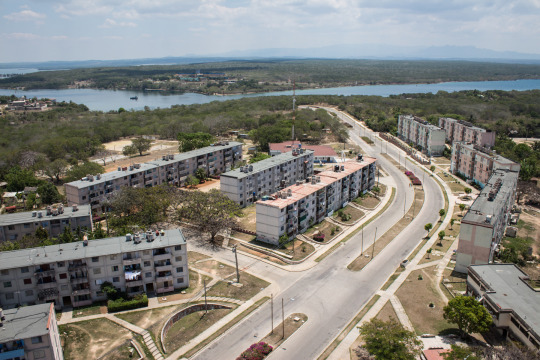
Ciudad Nuclear, Cuba as seen from the 14th floor rooftop of an unfinished apartment block.
The sun was beating down hard so the four of us ducked into the welcome shelter of a bar. We were the only customers; it was dark inside, cool, with flies buzzing lazily around the slow-moving ceiling fan. We ordered a round of beers – Cuban Bucaneros – and I held the cold can up to my baked skull, my temples, then rolled it between my hands allowing the frosty condensation to de-gunk my fruit-sticky fingers. I looked out at the market: an island of humanity, while all around it rose the empty shells of unfinished residential blocks. This handful of stalls was now the social heart of a city once built for thousands, and these people the last stubborn lives to remain amongst the ruins of Ciudad Nuclear.

Thousands of apartments built for construction workers and Soviet nuclear engineers now sit abandoned.
Back in 2014 I shared an article about my visit to an unfinished nuclear power plant in Cuba. It was no more than a concrete shell by the time I saw it, with a dome that made it look almost like a temple, left abandoned on the Caribbean coast.
The site had been built with Soviet money and know-how, and was to be accompanied by a brand new city for power plant workers. The Chernobyl reactors in Ukraine had the workers’ city at Pripyat; the Lithuanian reactor at Visaginas, likewise, had a model socialist city raised up almost overnight in its shadow; and here at Juragua in Cuba, the Soviets helped build ‘Ciudad Nuclear’: in English, simply, ‘Nuclear City.’
The USSR began working on the Cuban nuclear power plant in 1976, and Ciudad Nuclear was opened on 13th October 1982, to house the influx of Soviet scientists and engineers. Located six miles from the plant it was to feature 4,200 homes but the Cuban plant was never finished. Construction ground to a halt in 1989, as the funding dried up and the Soviet Union teetered on the brink of collapse. The intended workers’ city was left in limbo as a result: half finished, only part inhabited, an unsustainable cluster of concrete dwellings on a remote stretch of the Cuban shoreline.

Ciudad Nuclear, Cuba: view from the balcony of a spacious residential complex that never got finished.

A handful of residents still live in Ciudad Nuclear surrounded on all sides by empty blocks, and with the unfinished power plant just visible on the horizon.
I made the journey down to Juragua with friends. We hired a car in Havana, and drove for several hours to reach the site on the south side of the island. We slept in a casa nearby, a sweet little place down by the water’s edge, but on the day of our intended visit to the plant we found the place crawling with security guards. Later we’d come back, and we’d find another way inside the unfinished Juragua NPP – but first we spent an afternoon in Ciudad Nuclear.

A Cuban turkey vulture circles over the quiet streets of Ciudad Nuclear.
Ciudad Nuclear is a peculiar place. I want to call it a ‘ghost town,’ but that wouldn’t be entirely accurate. The handful of citizens who remain here are, for the most part, commuters. Some drive 20 miles to work in Cienfuegos, a larger town with a busy port and industrial sector. Not a lot of Cubans have their own transport though, which means that Ciudad Nuclear – an unfinished, out-of-the-way conurbation with little going on in terms of entertainment or employment – is doomed to a slow depopulation.
Leaving the market, we turned a corner and quickly found ourselves alone. Down the length of Ciudad Nuclear’s main street, only two parked cars and a couple of distant pedestrians were visible. Rounding a corner to the next street we met a small family and a donkey, but the rows of apartment blocks behind them looked desolate and bare.

Empty spaces inside a tower block planned for luxury apartments.
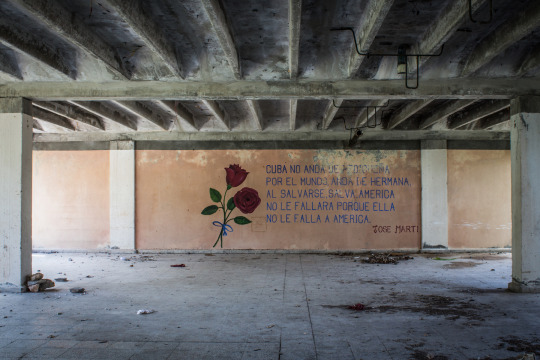
Poetry by José Martí appears on a wall in what might have been intended as a cafeteria.
Save for the occasional sheet flapping in the wind on some third-floor washing line, most of the buildings here seemed to be uninhabited; many looked like they had never been finished, their faded pastel exteriors wrapped around empty cement boxes. Inside one large ground floor space (a shop or a café?) I found a wall decorated with a verse by José Martí, Cuba’s most beloved revolutionary poet:
Cuba no anda de pedigueña Por el mundo, anda de hermana Al salvarse, salva América No le fallará, porque ella No le falla a América.
Poetry always loses a little in translation, but in English it means something like this:
Cuba does not go around the world as a beggar but as a sister By saving herself, she saves the Americas She will not fail, because she will not fail the Americas.
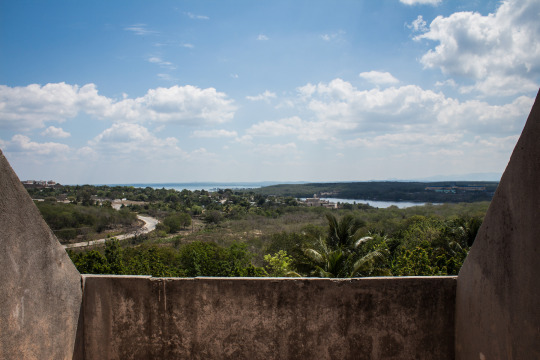
Looking east from Ciudad Nuclear, where a narrow strait connects the Caribbean to the inland Bay of Cienfuegos.
Some of the buildings around Ciudad Nuclear stood near to collapse. I looked inside a few, though there wasn’t much to see. The risk-reward ratio didn’t seem weighted in my favour, so for the most part when I saw ‘Derrumbe’ – ‘Collapse’ – written across a building, I kept away.
Heading back towards the centre we passed a naked tower block, the tallest we’d seen so far. Across its side were painted the words, ‘¡¡Socialismo o Muerte!!’ though it felt like an oddly subversive slogan, given the context. Socialism or Death. This place seemed to have a little bit of both.
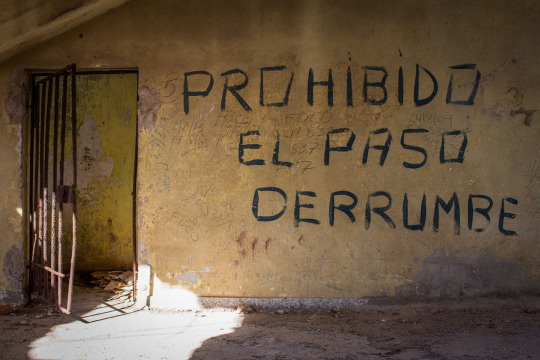

Socialism or Death in Ciudad Nuclear.
Gazing up at that graffitied ruin, I decided I wanted to climb it – to see how Ciudad Nuclear looked from the top. The stairs inside were intact, but there was little else to see inside the 14-floor skeleton; nothing but concrete all the way up. Reaching the top, I walked out of the stairwell onto an open-plan level that fell abruptly away at the edge; no windows, no handrail, just a sudden drop to the street.
Something flapped noisily nearby and I turned, in time to see a large dark bird take flight from its concrete perch on the fourteenth floor balcony. Later I’d be told it was a vulture.
Above the top end of the stairwell, a square hole opened to the rooftop and the sky. It took a bit of a scramble to get up there – balancing on a concrete bannister, catching hold of the ledge above and pulling myself up to the building’s summit – but it was worth the work.
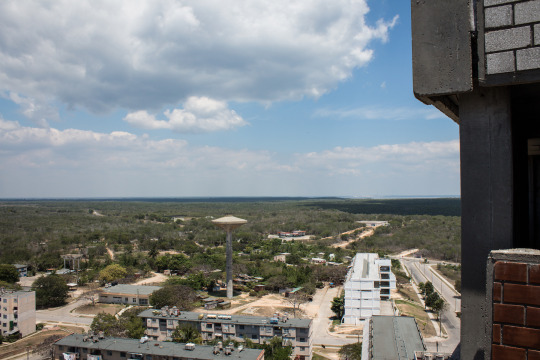
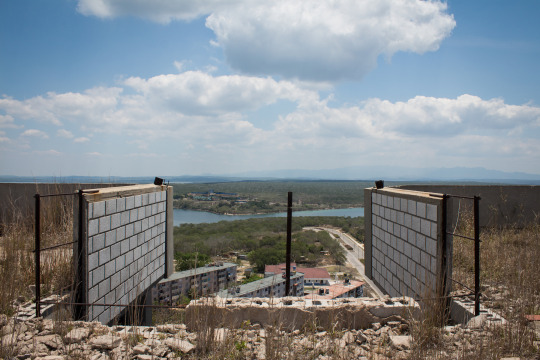
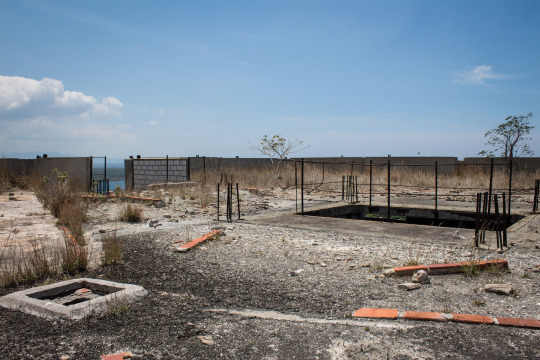
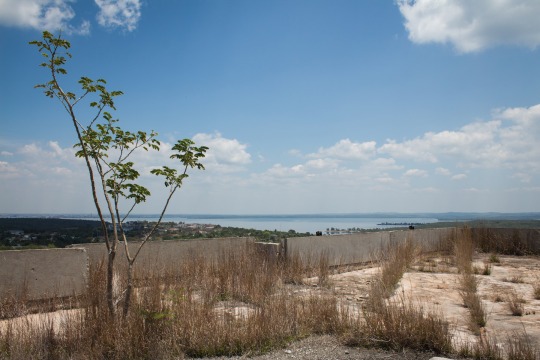
Nature is already reclaiming the rooftops of Ciudad Nuclear, Cuba.

Looking out across the Bay of Cienfuegos from a Ciudad Nuclear rooftop.
Stood up there in the sweltering sun, I traced the shoreline curving into the distance: the beach a ribbon of gold between the water and the forest. Below me the empty streets and unfinished buildings of Ciudad Nuclear fanned out in grid formation, a model city that never quite made it off the drafting table. Meanwhile along the coast, an abandoned 16-floor reactor building rose from the forest like some ancient temple ruin: a concrete mausoleum for the Cuban-Soviet nuclear programme.
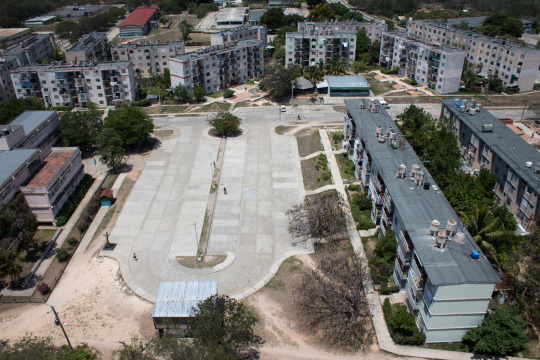
Designed to provide 4,200 homes, this is how the city looks today.


The building that started it all: six miles from the city sits the concrete shell of the Juragua Nuclear Power Plant.
-
Text and photo by Darmon Richter [adapted with permission from an article at [EX UTOPIA]
6 notes
·
View notes
Text

OXFORD UNION: MARINA CHATS IN MANGO SUIT
On February 10th, 2016 Marina headed to the Oxford Union to hold a speech and Q&A about the power of pop music, fans and songwriting industry.
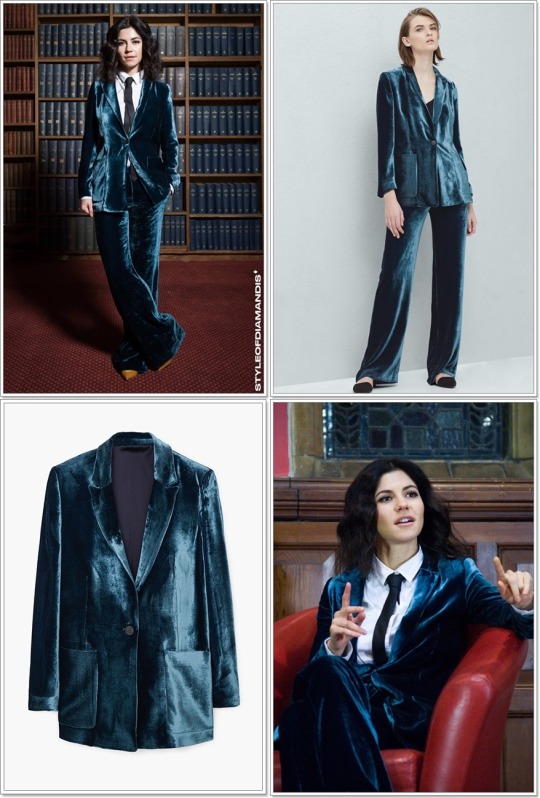
The Greek-Welsh beauté dressed up all formal in this stunning teal-colored velvet evening suit with oversized patch pockets and wide-leg pants from MANGO!
A crisp white poplin shirt, black silk tie and mustard-colored heels completed the look.

Marina completed her look with an orange velvet version of the above pictured Emmanuelle pumps from Malone Souliers’ Fall/Winter 2015 collection.
5 notes
·
View notes
Text
HIIO Launches New Nicotine Pouch Flavors & Smoke-Free Campaign

Building on the tremendous market success of HIIO's nicotine lozenge business, the company is excited to announce the launch of four new flavors, aimed at diversifying its product offering to meet the needs of a wider customer base. In conjunction with this launch, HIIO Technology is also proud to kick off a special campaign aimed at supporting smoke-free lifestyles by gifting exclusive gift boxes of nicotine pouches to participants. Since its inception, HIIO has remained steadfast in its commitment to innovation and exceeding customer expectations. With the unveiling of our latest flavors, including Spearmint, Cool Mint, Mango, and Grape Ice, HIIO now offers a total of eight distinct options. This expanded selection not only caters to diverse taste preferences but also allows users to choose from varying nicotine concentrations (3mg, 6mg, 9mg, 12mg), ensuring a customized experience tailored to individual needs and desires. To celebrate the launch and promote a smoke-free lifestyle, HIIO invites consumers to participate in its Smoke-Free Campaign. In this event, HIIO has launched numerous participation channels and partnered with global stores, distributors, and offline smoking cessation groups to support community development. Each gift box contains four different variants of nicotine pouches, ranging in nicotine content from 3mg to 12mg, allowing users to customize their experience according to their preferences and needs. "It's not just about offering great flavors; it's about empowering our customers to make healthier choices," says Vic, CEO of HIIO. "We believe in the power of technology to transform lives, and we're proud to be at the forefront of this movement." With a legacy of excellence in pharmaceuticals, HIIO nicotine pouches maintains rigorous standards across all aspects of production. Boasting eight years of experience in the field, the state-of-the-art facility ensures that every product complies with the European Union Good Manufacturing Practice (GMP) standards, guaranteeing the highest quality and safety benchmarks. As HIIO continues to lead the way in oral nicotine products, the company remains steadfast in its dedication to innovation, quality, and customer satisfaction. With the launch of these new flavors and the Smoke-Free Campaign, HIIO reaffirms its position as a trusted ally in the journey towards a smoke-free future. Join HIIO Technology in celebrating innovation and wellness. Discover the future of nicotine solutions and take the first step towards a smoke-free lifestyle. For more information, please contact: https://www.hiio.com/smoke-free-campaign About HIIO Technology: HIIO Technology is a leading provider of innovative nicotine solutions, committed to revolutionizing the way individuals experience nicotine delivery. With a focus on quality, variety, and consumer satisfaction, HIIO Technology is dedicated to empowering individuals to lead healthier lives. HIIO Info: Website: www.hiio.com Email: [email protected] Read the full article
0 notes
Text
Exploring Linguistic Bridges: 100 Hindi Words with English Meanings
Language serves as a vibrant bridge, connecting cultures and communities across the globe. In the vast tapestry of linguistic diversity, Hindi stands as a significant thread, woven intricately into the fabric of Indian culture. With over 500 million speakers worldwide, Hindi not only enriches communication but also offers a window into the rich heritage and traditions of India.
Today, let's embark on a journey through the corridors of Hindi vocabulary, exploring 100 words that have found their way into English with their meanings:
Aam: Mango
Achaar: Pickle
Admi: Man
Aloo: Potato
Angrez: Englishman
Aankh: Eye
Bachcha: Child
Bazaar: Market
Bhai: Brother
Bharat: India
Chai: Tea
Chalo: Let's go
Chutney: Relish
Dhobi: Laundryman
Dost: Friend
Guru: Teacher
Haveli: Mansion
Hukum: Order
Jungle: Forest
Karma: Fate
Khoya: Lost
Kutta: Dog
Loot: Plunder
Maharaja: King
Masala: Spice
Mehndi: Henna
Natak: Drama
Namaste: Greeting
Nirvana: Bliss
Paisa: Money
Pandit: Scholar
Pardesi: Foreigner
Pukka: Genuine
Raja: Prince
Roti: Bread
Samosa: Savory pastry
Shakti: Power
Shanti: Peace
Sher: Lion
Shiksha: Education
Swarg: Heaven
Tandoori: Oven
Thali: Plate
Thug: Cheat
Tikka: Spice mixture
Tilak: Mark on forehead
Videshi: Foreign
Yoga: Union
Zameen: Land
Zindagi: Life
Hindi, with its melodic cadence and expressive vocabulary, has left an indelible mark on the global linguistic landscape. As these words permeate through various languages, they serve as ambassadors of Indian culture, fostering cross-cultural understanding and appreciation.
Language is not merely a tool for communication; it encapsulates the essence of a culture, its history, and its people. Through the assimilation of Hindi words into English and other languages, we witness the interplay of cultures, the evolution of language, and the celebration of diversity.
Beyond mere words, these linguistic exchanges symbolize the interconnectedness of humanity, transcending geographical boundaries and fostering a sense of unity amidst diversity. As we continue to embrace the beauty of multilingualism, let us cherish the richness of each language and the stories it carries within its syllables. For More Please Visit - Common Hindi Words Translated to English
0 notes
Text
Black Friday, textile waste and considerations for a sustainable future

It is appropriate to address related aspects that, almost certainly, will be generated after the Black Friday purchases, encouraged on days like this.
The effects of fast-fashion are noticeable every day of the year, with textile waste being a problem similar to that generated by plastic[1], since the truth is that more than 92 million tons of clothing are sent to landfills each year and there is no separate collection of this waste stream for the time being. Other alarming data are that in Spain annual consumption per person is between 7 and 10 kg of clothing, most of which can be classified as disposable, which generates textile waste in an almost uncontrolled manner. According to data available from public administrations, textile waste represents 5% of municipal waste generated.
The new legislation on the circular economy and waste management[2] establishes a series of obligations, such as all those related to the expanded responsibility of the producer: new product design obligations to encourage recycling; duty to accept the return of reusable products[3]; duty to assume the financial obligations corresponding to the costs of separate collection, transportation, waste treatment and even cleaning public roads, if applicable. Thus, for example, under the name of the Asociación para la Gestión del Residuo Textil (AGRT) (Association for the Management of Textile Waste)[4], the constitution of a collective system of extended producer responsibility (SCRAP)[5] is planned, of which the multinationals Decathlon, H&M, Ikea, Inditex, Kiabi, Mango will be part and Tendam, and with which they plan to collectively comply with these new obligations enforceable as of December 31, 2024.[6]
Regional administrations and local entities must promote and implement separate collection for the subsequent treatment of textile waste. This obligation falls on local entities that, in the exercise of their powers, must implement a collection model that enables them to meet the objectives of separate collection, reuse and recycling set for textile waste in community and state regulations.
We understand it is necessary to have the voluntary collaboration of private collection points. That is, in order to encourage the delivery of textile waste by individuals for proper management, producers and distributors of textile products must be able to implement collection systems in a way that favours reverse logistics[7] and the return of textile products once used, and without being considered a waste manager, as long as they limit themselves to receiving textile waste delivered by individuals and do not carry out any type of waste management activity.
It is necessary to mention the new obligations that will come from the European Union regarding due diligence in matters of sustainability that will affect companies in the sector with more than 250 workers or with a global business volume of more than 40 million euros. This standard will force you to integrate due diligence into your business strategies[8]. This will entail establishing the actual or potential negative effects on the environment of its activity and the value chain, preventing, stopping or mitigating said adverse effects, the effectiveness of the strategy and due diligence measures and, ultimately, establishing a claim procedure.
There will also be standards on product sustainability (Ecodesign for Sustainable Products Regulation - ESPR)[9], on labelling, a digital product passport for textiles, or on the substantiation of the environmental information that companies use to promote the products they introduce into the market. In this regard, the new Green Claims Directive[10], which is about to be approved, aims to establish common criteria against greenwashing[11], in order to apply greater control and transparency to environmental information and the so-called environmental labelling that companies use, voluntarily, to promote their products. Indeed, the future standard establishes minimum standards on how to substantiate and communicate this type of declaration (which must be specific to all or part of the product, truthful, precise, verifiable and justified).
All these considerations taken together and without a doubt, can serve to anchor the aforementioned fast-fashion, although they may not be enough if we do not have binding ecodesign standards, for example. Now, we are already facing a paradigm shift that, over time, will provide us with means to better prevent littering and, where appropriate, mitigate the negative environmental impacts of textile products, as well as promote reuse and high quality recycling. At least we have hope.
Source
Víctor Moralo Iza, Black Friday, residuos textiles y consideraciones para un futuro sostenible, in: El País, 24-11-2023, https://cincodias.elpais.com/cincodias/2023/11/24/legal/1700810526_982955.html
[1] Read also: https://www.tumblr.com/earaercircular/728619189968027648/will-we-ever-be-able-to-recycle-our-clothes-like?source=share
[2] Read also: https://earaercircular.tumblr.com/post/684755137609252864/what-the-spanish-waste-law-brings-harmonization
[3] https://www.europarl.europa.eu/RegData/etudes/BRIE/2023/745707/EPRS_BRI(2023)745707_EN.pdf
[4] These days the news is the “birth” of the first collective system for the management of textile waste in Spain: Seven multinationals from the textile industry have joined together in what is the first Collective System of Extended Producer Responsibility (SCRAP) in the sector, with the aim of giving "a collective boost" to textile recycling in Spain. The so-called Association for the Management of Textile Waste (AGRT) is supported by the companies Decathlon, H&M, Ikea, Inditex, Kiabi, Mango and Tendam. https://www.productordesostenibilidad.es/2023/01/una-asociacion-para-la-gestion-del-residuo-textil-agrt/
[5] Sistema Colectivo de Responsabilidad Ampliada del Productor (SCRAP). Read also: https://www.tumblr.com/earaercircular/721717700267753472/as-of-last-saturday-on-textile-producers-in-the?source=share
[6] Read also: https://www.tumblr.com/earaercircular/734956569878560768/waste-without-management-systems-for-waste-and?source=share
[7] Read also: https://www.tumblr.com/earaercircular/665487447558438912/dutch-start-up-raises-millions-in-investment-to?source=share
[8] In line with green transition in the EU, fresh policy proposals are making their way forward. One of them, the CSDDD/CS3D – if adopted – requires serious steps to be taken by companies. Obligations regarding corporate sustainability due diligence along the full value chain are to be expected. The directive aims to make large companies responsible for environmental and human rights violations that occur along their value chains. Thus, companies are mandated to identify and address impacts on human rights and the environment, integrating due diligence into their operational strategies. Company directors are tasked with overseeing due diligence implementation and incentivized to contribute to climate change mitigation. https://www.dentons.com/en/insights/articles/2023/november/9/new-legislative-proposal-on-corporate-sustainability-due-diligence-directive
[9] The proposal for a new Ecodesign for Sustainable Products Regulation (ESPR), published on 30 March 2022, is the cornerstone of the Commission’s approach to more environmentally sustainable and circular products. The proposal builds on the existing Ecodesign Directive, which currently only covers energy-related products. https://commission.europa.eu/energy-climate-change-environment/standards-tools-and-labels/products-labelling-rules-and-requirements/sustainable-products/ecodesign-sustainable-products-regulation_en
[10] What is the Green Claims Directive? The Green Claims Directive aims to stop greenwashing by setting standards for environmental claims. The spark came from a 2020 study showing that 53% of environmental claims in the EU were vague or misleading. https://environment.ec.europa.eu/publications/proposal-directive-green-claims_en
[11] Read also: https://www.tumblr.com/earaercircular/729425164711886848/sustainability-more-information-is-forthcoming?source=share
0 notes
Text
Labour Rights Breaches by Multinational Corporations (MNCs): Consequences and Promising Solutions
This article on 'Labour Rights Breaches by Multinational Corporations (MNCs): Consequences and Promising Solutions' was written by Harshit Yadav, an intern at Legal Upanishad.
Introduction
MNCs are large enterprises that operate in numerous countries and wield substantial economic and political power in the global marketplace. They are frequently active in a variety of industries, including manufacturing, services, and natural resource exploitation, and they have played an important role in driving economic growth and development in many parts of the world. However, MNC operations have been linked to labour rights breaches such as poor working conditions, low salaries, and worker exploitation. These infractions have been documented in a variety of sectors and places, ranging from textile sweatshops to mining operations in poor countries. MNCs have had a huge impact on the global labour market, with many of these corporations relying on cheap workers from developing nations to improve their profitability and competitiveness. As a result, MNCs have been reprimanded for contributing to the growing wealth disparity and increasing global economic inequality. Given the growing importance of MNCs in the global economy, governments, civil society organisations, and other stakeholders must address worker rights breaches by these businesses. This article attempts to provide an overview of the topic of labour rights breaches by MNCs, assessing the consequences and potential solutions.
Overview of Labour Rights
Labour rights are a set of legal and human rights principles that protect workers' rights at work. These rights are recognised internationally and are enshrined in a variety of legal frameworks, including ILO treaties, national legislation, and collective bargaining agreements. The International Labour Organisation (ILO) is a United Nations specialised body dedicated to promoting social justice and good working conditions around the world. The International Labour Organisation (ILO) has produced a set of core principles and rights at work that are recognised as basic human rights. These are the principles: Freedom of association and the right to collective bargaining - This principle ensures that workers have the right to form or join trade unions and to engage in collective bargaining with their employees Elimination of forced labour - This principle prohibits all forms of forced labour, including slavery, debt bondage, and human trafficking. Abolition of child labour - This principle prohibits the employment of children below the age of 15 and sets standards for the protection of children's rights in the workplace. Elimination of discrimination in employment and occupation - This principle prohibits discrimination in employment based on race, gender, religion, national origin, or any other grounds. Promotion of decent working conditions - This principle encompasses a range of issues related to working conditions, including safe and healthy working conditions, fair wages, and reasonable working hours
Case Studies of Labor Rights Breaches by Multinational Corporations
Apple's Chinese Suppliers: A series of studies in 2011 found that workers in Apple's Chinese supply chain were exposed to long working hours, low wages, and hazardous working conditions. Workers were also exposed to harmful chemicals in some circumstances, resulting in major health concerns. Furthermore, several vendors were discovered to be using child labour. Apple responded by evaluating its suppliers and instituting new procedures aimed at improving labour conditions. The Rana Plaza Factory Collapse in Bangladesh occurred in 2013 when a building holding numerous garment companies fell, killing over 1,100 employees and injuring thousands more. Mango and Benetton were among the international brands whose clothing was made in the plants. The building had structural flaws and was unlawfully built, and the workers were ordered to keep working despite cracks in the walls. This incident brought to light the pervasive problem of unsafe working conditions in Bangladesh's garment industry, as well as the need for improved regulation and enforcement. In Excel Wear vs. Union of India (1979), The Indian Supreme Court recognised the right to strike as a basic right guaranteed by the Indian Constitution. The decision declared that workers had the legal right to protest unfair labour practices and that the government could not take punitive action against striking workers unless there was a solid basis. The judgement contributed to the strengthening of employees' rights in India and ensured that they have legal protection when protesting against unfair labour practices.
Impacts of Labour Rights Violations
Violations of labour rights have a severe impact on employees, their families, and communities. These consequences can be both immediate and long-term, affecting different elements of their lives such as physical and mental health, social and economic position, and access to justice and remedies. Physical damage is one of the most immediate consequences of labour rights breaches. Workers may be subjected to dangerous working conditions, such as chemical exposure or inadequate protective equipment, which can result in accidents, diseases, and even death. This can be disastrous not only for the workers but also for their families and communities. Infringement of labour rights can have serious mental health implications. Workers who are forced into exploitative working conditions, such as excessive hours, poor pay, and no job security, may suffer from stress, anxiety, depression, and other mental health problems. This can have an impact on their ability to work as well as their overall quality of life. Violations of labour rights can also lead to social and economic marginalisation. Workers who are underpaid, denied benefits, and subjected to discrimination may struggle to make ends meet and provide for their families. Poverty, homelessness, and food insecurity can result, affecting their physical and emotional health, as well as their children's schooling and future chances. Moreover, labour rights violations can create barriers to access to justice and remedies. Many workers may fear retaliation or lack the resources to seek legal remedies, such as filing a complaint or taking legal action. This can further perpetuate a cycle of exploitation and abuse, as workers may be hesitant to speak out and hold their employers accountable for fear of losing their jobs or facing other negative consequences. Contact Us and avail the best assignment help for students available online!
Legal and Policy Responses
The International Labour Organisation (ILO) establishes worldwide employment standards through treaties and guidelines that member countries are obliged to comply. The UN Guiding Principles on Business and Human Rights establish a framework for multinational corporations (MNCs) to respect human rights, particularly labour rights, and to take actions to prevent and redress negative human rights consequences. Countries have their own labour laws and regulations that define standards for working conditions, minimum salaries, and collective bargaining at the national level. Many nations have also enacted corporate social responsibility (CSR) frameworks or guidelines to urge Multinational Corporations (MNCs) to respect human rights, particularly employment rights, in their operations and supply chains. Despite these frameworks, obstacles and limits remain in addressing MNCs' abuses of labour rights. One difficulty is the lack of international labour standards enforcement mechanisms, which can limit their efficacy. Furthermore, certain countries may lack effective labour laws or have poor enforcement procedures. MNCs may also refuse to comply with employment regulations or use weak enforcement procedures in some nations. Civil society organisations and labour unions play an important role in advocacy for labour rights and monitoring adherence to work standards. They can raise awareness about violations of labour rights, campaign for legislative and legal reforms, and engage in collective bargaining to improve workers' working circumstances.
Corporate Social Responsibility and Business Ethics
In recent years, corporate social responsibility (CSR) and business ethics have received more attention. MNCs play an important role in promoting labour rights and avoiding labour rights breaches. CSR refers to a company's voluntary efforts to enhance its social and environmental effects. In contrast, business ethics refers to the moral principles that influence corporate decisions and activities. Both notions are intimately related to labour rights and can aid in their promotion in MNCs. MNCs, for example, can implement CSR policies that prioritise workers' rights, such as fair wages, safe working conditions, and free association. CSR and business ethics programmes, on the other hand, confront a number of problems and limits. One of the most significant issues is that they are entirely voluntary and non-binding. This means that multinational corporations might choose to disregard or prioritise other goals, such as profit maximisation, over social responsibility. For example, a firm may opt to outsource production to a supplier in a nation with weaker labour standards in order to save money, albeit knowing that this may result in abuses of labour rights. Another issue is the absence of effective monitoring and enforcement procedures. MNCs may implement voluntary codes of conduct or CSR policies, but ensuring that their vendors and contractors follow these standards can be problematic. Similarly, ethical supply chain management practices such as auditing and inspecting may not always be helpful in detecting or preventing workers’ rights breaches. Furthermore, the influence of CSR and business ethics programmes may be limited. For example, multinational corporations (MNCs) may primarily focus on improving worker conditions in their own operations rather than addressing bigger structural concerns such as poverty and inequality. Furthermore, these measures may fail to address the underlying causes of labour rights breaches, such as ineffective labour legislation and enforcement procedures.
Conclusion and Suggestions
Abuse of labour rights by multinational corporations is a prevalent and ongoing concern in many regions and businesses. These violations include child labour, forced labour, exploitation, and hazardous working conditions, all of which have serious implications for worker well-being and achieving sustainable development. Several initiatives can be taken by policymakers, MNCs, and civil society organisations to promote labour rights and prevent breaches by MNCs. Labour regulations that are in line with international norms and protect employees' rights can be enacted and enforced by policymakers. MNCs can adopt and put into practice ethical business practises that prioritise workers' rights and aim to eliminate labour rights breaches in their supply chains. Civil society organisations can play an important role in monitoring and exposing violations of labour rights, as well as pushing for policies and practices that promote decent work and social justice. Future research directions include assessing the efficacy of existing labour rights frameworks and initiatives, investigating the impact of labour rights violations on workers' mental health and well-being, and investigating the interconnectedness of labour rights violations with other forms of discrimination such as gender and race. Promoting and protecting labour rights is essential for advancing human dignity and well-being, and preventing labour rights violations is the responsibility of all stakeholders. By working together, we can create a world where all workers are treated with dignity and respect.
List of References:
Prasadi Wijesinghe, "Human Rights Violations by Multinational Corporations: Nestle as the Culprit", SSRN, 14 March 2018, available at: https://papers.ssrn.com/sol3/papers.cfm?abstract_id=3136321 Laura Boudreau, "Multinational enforcement of labor law: Experimental evidence from Bangladesh’s apparel", Princeton School of Public and International Affairs, 15 May 2020, available at: https://spia.princeton.edu/sites/default/files/2020-09/boudreau_2020_05.pdf "Labour Law Primer for Multinational Companies in India", Singhania & Partners, available at: https://singhania.in/admin/blogimages/doc-3817594.pdf Read the full article
0 notes
Photo

พามารู้จัก Mango Power Union อุปกรณ์จ่ายพลังงานไฟฟ้าแบบพกพา
0 notes
Text
Mango Power Union Vs EcoFlow DELTA Pro: Which is the Year’s Best Power Station?
Mango Power Union Vs EcoFlow DELTA Pro: Which is the Year’s Best Power Station?
Background and Introduction You may not have noticed with everything else going on, but over the past year portable power stations have become a hot topic of discussion. A ton of new products have come out recently from established brands like Jackery, EcoFlow, and Bluetti. A few have gotten their start via crowdfunding, like the Bluetti EP500 (5.1 kWh/3 kW) which generated 3.1M USD on…

View On WordPress
0 notes
Photo
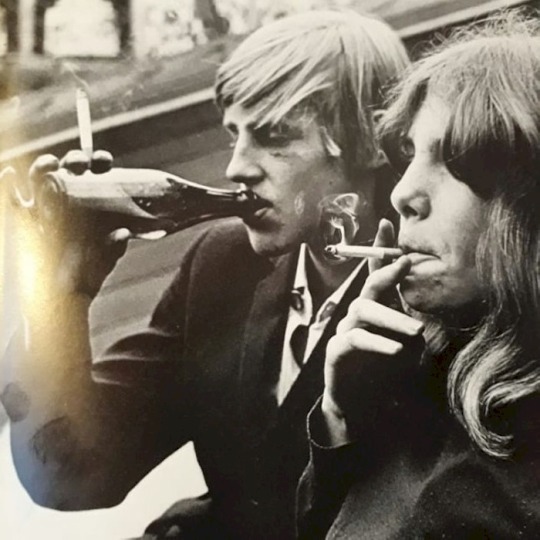
Dustedandsocial Bestof 2021 part3
Pictured: Monokultur
01. Nape - Forum Freaks 02. Monokultur - Decennium 03. Aum Taeppers - Ferrio 04. Antoine Loyer & Mégalodons malades Bégayer - Il y a d'autres chiens rasés 05. Bobby Would - Natural Killer 06. Some Exercise - Some Bias 07. Snake Union - Nattmara 08. Houschyar - Temassiz 09. Spivak - Bitumen Frenzy 10. Lili Putana - You are asked to feel at ease in a place where you will never belong 11. Wukir Suryadi - Sembilan 12. Froid Dub - Frozen Chips Sandwich 13. Schade - Pas assez 14. Véhicule - Poddema 15. CIA Debutante - Pier 16. Palo Alto & Richard Pinhas - The Tears Of Nietzsche 17. Alessandra Novaga & Stefano Pilia - Glimpse #9 18. Delphine Dora & Jackie McDowell - All This Struggle 19. Heta Bilaletdin - Varjoi 20. Sagat - Money Magic 21. Euphoria Echoes Of Inotai - Loops Of Hope 22. Roy of The Ravers - Day 7 in D# 23. Lostsoundbytes - Street Stalker 24. Mazut - Schtanza 25. Wendy Lavone - It's Faeces That Make The World Go Round 26. Ena - 51th 27. Miss Mårble & V. Luchansky - Bär 28. Saadet Türköz & Nils Wogram - Navel 29. François Dumeaux - alma 30. Claypipe - Yeah I Making Gold
Download: https://mega.nz/file/ONVkyBgJ#CfOap4wZm5KEVmbQRBfWf9MWQlsOVZFV11X7HTQJSlM (copy link url and paste if clicking on embedded link doesn’t work. “href.li” may delete key in url when it redirects from tumblr)

Dustedandsocial Bestof 2021 part4
Pictured: Teresa Winter
01. Amygdala - Synthetic Humans 02. Schulverweis - Blut 03. Teresa Winter - Hard Life In Plastic 04. Reymour - Cent Abus 05. Klara Lewis & Peder Mannerfelt - You Need to Be Kind 06. Tupperwear - La Costa De Cemento 07. Dame Area - La Doble Luna 08. Wulffius - I Am Weird 09. RM - Point 3 10. Human Koala - I'll Be Fine 11. Elena Colombi ft Ece Ozel - Pine Seedlings 12. Maenad Veyl & The Sarcasm Ensemble - Irreconcilable Differences 13. Taurus - Das autonome Wesen 14. Пурпурный Дядя - Taylak feat. Misha Sultan 15. Troth - Komodo 16. La Union Metalurgica - Control de Calidad 17. Dollkraut - Amoebe 18. S Olbricht - Beat Me Suzy Mango 18. Weith - Forever Today 20. The New Me - Dexter 21. Liliane Chlela - Charr 22. Yeulmaus - Mother 23. Kesa Getame - A1 24. gFFr - Haptic Feedback 25. Ambulance vs Ambulance - Colourful Ring Of Death 26. Merlin Nova - Big Heart, long time love 27. Heimat - Deine Frau 28. Boli Group - cottagecore crisis 29. Bolivian fireships - Sturm and Drang [JGSparkes reinterpretation] 30. YL Hooi - WO Love
Download: https://mega.nz/file/7YcShJZC#sumnis_EGNY2MaIolwilgNOSDIqiGm0PTGLzgoa6Oh0 (copy link url and paste if clicking on embedded link doesn’t work. “href.li” may delete key in url when it redirects from tumblr)
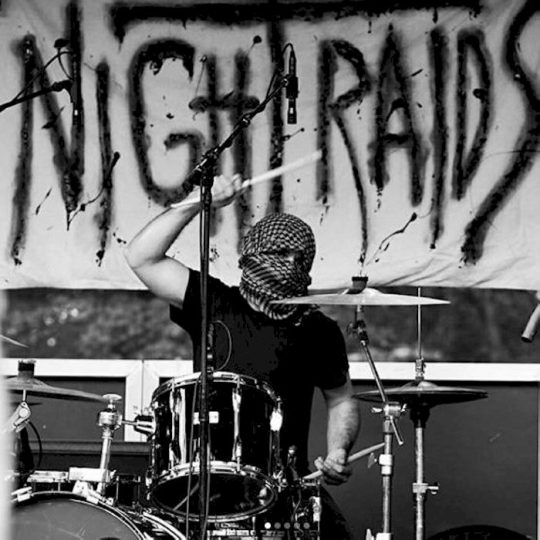
Dustedandsocial Bestof 2021 part5
Pictured: Mephisto Halabi
01. Electric Drywall Band - 3 02. Psychic Graveyard - Hijack a Star 03. NH Meth - Unknown Gen 04. YOR - Look At Me 05. Mephisto Halabi - Watch On The Orient part I 06. Pure Shit - A New Word For Love 07. Z.B. AIDS - Djerek Bailey 08. Dead Neanderthals - Scalp Wounds 09. Brigitte G. - Echoes 10. Jerusalem in My Heart - ‘Ana Lisan Wahad (feat. Farida Amadou & Pierre-Guy Blanchard) 11. Zeena Parkins, Mette Rasmussen, Ryan Sawyer - Begiunners, begges, beattle, belt, believers 12. Les Conférences Bunker - Girouette Amulette 13. Senyawa - Kabau 14. Jean-Luc Guionnet & Will Guthrie - The RUBDOWN 15. YLP - The Image of 36 16. Maximum Ernst - UFA-USA 17. Jérôme Noetinger x Lionel Fernandez - CALCUTTA 18. Offensive Defiant Disorder - Adversary 19. FS Massaker - Her Metal 20. Aaron Dilloway & Lucrecia Dalt - Demands Of Ordinary Devotion 21. ORCHESTRA OF CONSTANT DISTRESS - Dedication 22. Jaco - Las procesiones 23. Drop Zone - Tiny Towel 24. Laughing Gear - Flake 25. NP [Jad Atoui & Anthony Sahyoun] - Higgs Field 26. Al Karpenter - EYES WITHOUT FACES 27. Anji Cheung - Even Flowers are Black at Night 28. maurice lɔndɔn - of unsound mind 29. Skogar - Passing The Torch 30. Noiseboys - Power Machines (take 1)
Download: https://mega.nz/file/vIsCBQ6S#RZ0kc3c-oB7gbzz3lMttVzxUA5qEi4LqT-IeLd3peR8 (copy link url and paste if clicking on embedded link doesn’t work. “href.li” may delete key in url when it redirects from tumblr)

Dustedandsocial Bestof 2021 part6
Pictured: Theoreme
01. Panoptique - Slippery 02. Cosey Mueller - Antisozial 03. Double Job - Decouverte 04. Maraudeur - Le Couloir Du Soir 05. Mary Bell - Dog on a Leash 06. DIE A.R.D. - Laufband 07. Fake Last Name - Gadfly 08. Theoreme - Radionucléides 09. Hits - Linoleum Bureaucracy 10. Le Chemin de la Honte - Le traffic des cours 11. Kneeling In Piss - Return, Return _ Types of Cults 12. Los Pirañas - Sir de Gusano 13. Emily Robb - Saucer 14. Morświn - Stary skończony 15. Nusidm - Jealousy 16. Calamita - Sidi Mansour 17. Catalina Matorral - Grande Table 18. Gotou - WET背 19. Moin - No to Gods, No to Sunsets 20. Pays P. - Fureur 21. Katherine - Eye of the Beholder 22. Middex - Host 23. Princess Diana of Wales - Still Beach 24. Wadada Leo Smith & Bill Laswell - Tony Williams 25. Kris & Tavi - So, That Happened 26. Cynthia & Dupree - Future Plant Music 3 27. Ghédalia Tazartes & Rhys Chatham - Encore 28. Unda Fluxit - ( sunset rain) طلو و باران 29. April Magazine - Sugar Daddy 30. Amateur Hour - Baby You are all I want
Download: https://mega.nz/file/CQtUALoT#ktx2nRNh1QDG3wBrMRVRu60WOJ01iDFb5xwN81g7UUA (copy link url and paste if clicking on embedded link doesn’t work. “href.li” may delete key in url when it redirects from tumblr)
part1 / part2
9 notes
·
View notes
Text
Tandem - Platonic Obikin
Hello, welcome to week 3 of Mango drabbles. I have been in the Star Wars fandom since I was six years old and I have been a fan of Pacific Rim since it came out in 2013. Today, some people in the NSWC server were watching Pacific Rim and I thought it would be incredible to do a crossover of the two.
Tandem
Characters: Anakin Skywalker, Obi-Wan Kenobi, Marshal Stacker Pentecost, Tendo Choi
Rating: T
Word Count: 1595
I recommend listening to this when you read.
Kaiju (Japanese): Giant Beast
Jaeger (German): Hunter
Drifting (English): Two minds being joined into one for combat
“Rebel Blue, report to Bay 05, Level A-42, repeat, Rebel Blue, report to Bay 05, Level A-42.”
The blaring of the nuclear siren rings in Anakin’s ears as his eyes shoot open. He blearily rubs his eyes as the words repeating over the loudspeaker register.
“Rebel Blue, report to Bay 05, Level A-42, repeat, Rebel Blue, report to Bay 05, Level A-42. Kaiju. Code name: Insidious. Category 3”
He grins, adrenaline flooding his system. He jumps out of his bunk, pulls on a shirt, his dog tags jingling. His copilot, Obi-Wan slept peacefully on the lower bunk. Anakin slaps Obi-Wan’s mattress and then gently slaps his face.
“Obi, wake up old man! We got movement, we’re being deployed!”
Obi-Wan groans and Anakin takes that as a signal to keep prepping. He darts over to their mini kitchen, pulling out two protein bars. As Obi-Wan emerges from his bunk, pulling on a shirt, Anakin throws a bar to him.
“G’morning.” Obi-Wan’s lightly accented voice rings through the air, slurred with sleep. “I see we’ve got a big one.”
“Yep! And before you ask, it’s 1 A.M.”
Obi-Wan sighs. “Can’t these damn Kaiju appear according to my circadian rhythm?”
Anakin laughs and Obi-Wan smiles. They are interrupted by a banging on the door. “ObiAni, hurry it up. Time for the drop.”
Obi-Wan grabs his leather jacket from the chair he draped it over last night and tosses Anakin’s to him. Together, they don them and stride out the door.
They make their way down to the launch bay. The massive steel doors are emblazoned with their sigil and “Rebel Blue” painted in white calligraphy. As the doors creak open, Anakin whoops.
“Let’s get this show started, boys!” He practically bounces into the room.
A small army of techs is waiting for them. They shed their jackets and step forward, taking their positions. Like squires to the knights of old, the techs help them into their armor. As Anakin’s breastplate is being attached, he looks at Obi-Wan. Obi-Wan meets his gaze and winks. About thirty seconds later, they are suited up. The white armor shines under the fluorescent light. Together, they step forward and put on their helmets. The door to their Jaeger opens and Anakin walks in, followed closely by Obi-Wan and three techs. Together, they lock their feet in place. The techs secure their back harnesses and the third hands them their hand consoles. As the techs exit, a voice rings out through their headsets.
“Welcome to the party, ObiAni!”
Obi-Wan grins and replies, “Hello Tendo. What’s the weather like?”
The two men can hear Tendo’s grin. “Ah you know how it is. Cloudy with a chance of Kaiju blue.”
“So perfect weather then.” Anakin rolls his neck, making sure he’s all stretched out.
“If you say so.”
“Engage drop, Mr. Choi.” The stern, no nonsense voice of Major Pentecost interrupts their banter. The two men immediately switch to battle mode. If Pentecost is here, then it’s time to roll out. Making sure their comm channel is muted on their end, Anakin turns to look at Obi-Wan.
“Ready to add another scratch to our wall of kills, Obi-Wan?”
“Only if you are. And make sure to cover our side this time, my side still hurts from the last one.”
“I told you, it came out of nowhere.”
“No, it clearly came out from the left, which is what you’re supposed to be covering.”
“If you recall, I was a bit busy with the prehensile tail!”
The hiss of the pod door sealing interrupts their banter. Both men do a final systems check before Obi-Wan reopens the comm channel. “Rebel Blue ready for the drop.”
With that confirmation, the floor plummets. Anakin’s stomach drops to his feet as the pod descends rapidly down the shaft. Instinctually, he lets out a scream of joy and terror. He looks at Obi-Wan and sees gritted teeth and closed eyes. He remembers that the drop is the part Obi-Wan hates. The pod slows and settles gently onto the shoulders of their Jaeger. A towering two hundred and eighty foot extension of their bodies. The pod, which is actually the head of the Jaeger rotates first left, then right, confirming mobility. Anakin and Obi-Wan adjust to the moving pod as the Marshall orders initiation of pilot to pilot protocol.
Around them, filling their ears, Rebel Blue’s beautiful voice speaks, “Pilot-to-pilot connection protocol sequence.”
Anakin locks eyes with Obi-Wan. The soft blue glow of the helmet coats Obi-Wan’s features. The last time they dropped together, they took a pretty big hit. It took all three of them a few months to recover. Now, Rebel is as good as new and Anakin swears he isn’t going to let anything happen to Obi-Wan. The hum of Rebel’s nuclear core rattles the massive avatar. Obi-Wan nods to Anakin, a gesture of trust and faith that Anakin returns. They are some of the best pilots in the fleet and they know it. They will do their job and return to their friends and family. After all, they have a little sister waiting for them.
Dimly, they hear the sounds of the bay doors opening as Rebel wakes up around them. They stumble slightly, jolting forward in their harnesses as the massive transport begins to roll towards the hanger doors. Through the viewscreen, they can see small helicopters buzzing like bees around their head. As the transport rolls off the launchpad into the unforgiving ocean, Anakin comms Command.
“Rebel Blue, ready and aligned.”
“Rangers, this is Pentecost. As you know, this is a category 3. Last time you fought a C.3, you were nearly split in two. Try not to do that again. Prepare for neural handshake.”
Tendo’s voice takes over. “Starting in 15 seconds. 15…”
As the countdown begins, Anakin mutes their channel. “What are we thinking, Obi-Wan? Music?”
“Oh definitely not. We have been out of it for a while, let’s not get cocky, even though that’s your specialty.”
Anakin rolls his eyes. “Fair enough. Can’t wait to hear your grating voice in my head.”
“The feeling is mutual.”
“3… 2… 1…”
Rebel Blue speaks over Tendo, “Neural Handshake initiated.” Anakin closes his eyes, focusing on breathing. A sensation not unlike drowning overtakes him. His whole body goes cold, spreading from his head, down his torso, through his legs and arms. There is a pressure settling around him from all sides, slowly squeezing tighter and tighter as the memories begin.
Obi-Wan, meeting Anakin for the first time in college.
Anakin, swimming with Ahsoka, shouting and laughing.
Anakin, the day his mother died, face wet with tears as the cancer finally took her.
Obi-Wan, age 5, playing with his parents in a verdant, rolling field.
Obi-Wan’s grief and guilt after his last copilot died.
Anakin’s insecurity at being compared to Obi-Wan’s former copilot.
Obi-Wan and Anakin, the first time they drifted.
Obi-Wan and Anakin, becoming ObiAni.
In tandem, their eyes snap open as the link finalizes. Two men and their hulking avatar, a perfect union of flesh and steel. ObiAni feels cold wind and sea spray on his face. He blinks, trying to dislodge a water droplet that isn’t even there. When you drift, you aren’t just melding with your copilot, you are embodying the Jaeger too. He hears and feels laughter echoing in his head.
I missed this. I missed you.
Was it Anakin or Obi-Wan who said that? It didn’t matter. All that matters is Anakin and Obi-Wan are one. Two halves of a whole, greater than the sum of its parts. ObiAni breathes, feeling his chest rise and fall as the heartbeat of Rebel Blue thrums in his ears.
“Neural handshake strong and holding.” Tendo’s voice brings him out of his reverie.
Right hemisphere, calibrating. ObiAni speaks, raising his left hand out to his side. Metal creaks as Rebel Blue obeys his command. He rotates his arm so his palm is facing up and slowly curls his fingers into a powerful fist.
Left hemisphere, calibrating. This time, he brings his right arm up, repeating the motion. He bends his arms together and thrusts them forward in a powerful double punch.
“Proofed and transmitting.” Rebel Blue coos in his ear, speaking to him and Command. ObiAni flexes his fingers. He curls his left hand into a fist and his right hand he leaves palm up. Fist meets palm in a powerful show of strength and aggression. ObiAni cracks his neck and views the HUD of Rebel Blue critically, making sure all systems are green.
Pentecost begins giving them orders. “Rangers, you are to keep Insidious away from the coastline. Terminate it quickly then get back to base. As you know, breach activity has been increasing, I don’t want you caught in an ambush. Copy?”
Copy that, sir.
ObiAni switches off comms and the bodies of the men that were Anakin and Obi-Wan look at each other. Obi-Wan’s face has a thin layer of sweat. Anakin’s breathing is spiking as adrenaline takes over. Their hearts beat in tandem with the nuclear core of Rebel Blue.
You’re in my head, you know what I’m thinking.
I do.
Let’s go get this sonuva bitch.
Flexing his muscles, ObiAni begins to walk and Rebel Blue follows suit, water sloshing around their ankles. Death could be on the horizon for ObiAni but now, he is whole, he is powerful, and he is going to save lives.
And that’s all that matters.
19 notes
·
View notes
Text
The Kohbar Resplendent
The artist Shalini Karn has used the Covid lock-down time to present us with a wall-sized (7x7 foot) new interpretation of the Kohbar.

A magnificent Kohbar hovers large over the land its top reaching up into a dark blue sky with barely visible distant mountains.
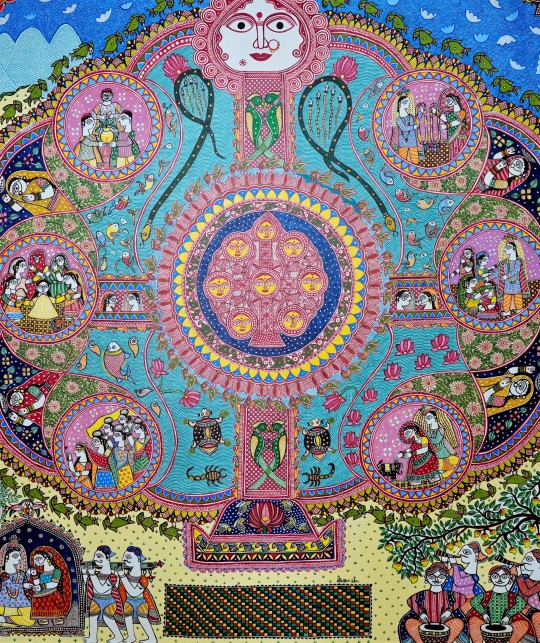
The Kohbar is elaborately decorated. Six symmetrical medallions, three on each side, circle the center while in their four interstices a naina jogin, in red or yellow sari with one eye uncovered, protects the wedding from evil misfortune. The light blue water teems with gaily colored and auspicious life, turtles, small fish, crabs, snakes and lotus flowers.
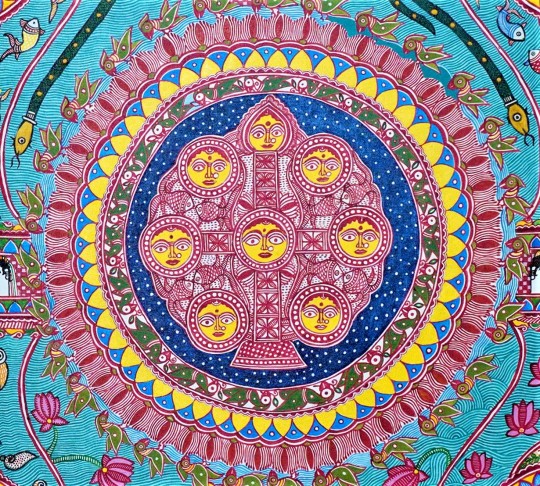
The Kohbar’s center is a second kohbar,a shining purain of yellow lotus leaves in an architecture of finely drawn red lines set in concentric circles of dark blue water, green parrots, yellow ornamentation, and the red pistils of the lotus plant. This second kohbar is a microcosm of the ‘maha’ (greater) Kohbar that surrounds it and together they are a paean to the power of the feminine.
This Kohbar is a force of love and joy and union.
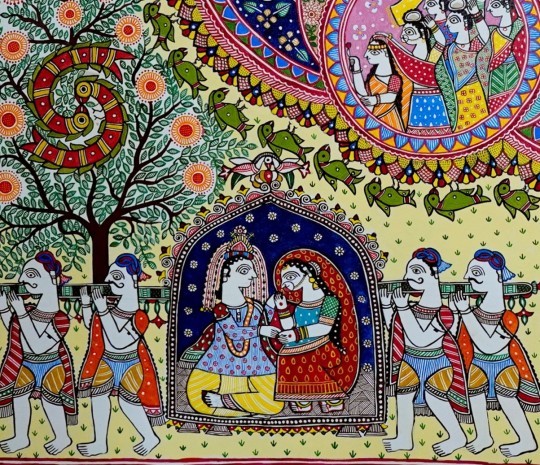
There is no longer the submissive bride alone in the palanquin being taken to an uncertain future but rather husband and wife together, facing each other, hand in hand, being carried to their new life. A pair of entwined love birds in a Kadamba tree sacred to Krishna is next to the palanquin. “And what is Krishna if not love?” asks Shalini Karn.
On the other side are musicians, drummers and horn players, making joyous
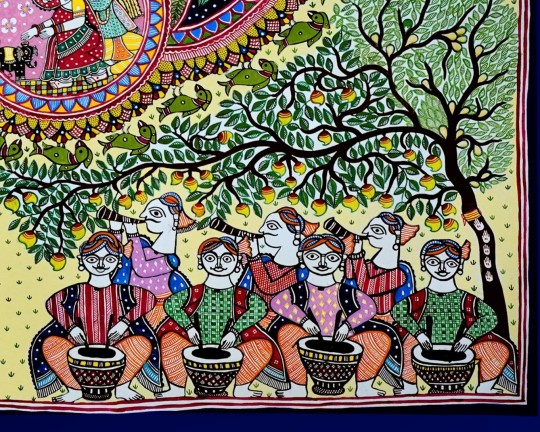
music under a mango and mahua tree where, before the actual wedding ceremony, the bride and groom held a ritual marriage with the trees for a happy and long marriage. Note the bride’s rice paste hand prints on the tree trunk and the yellow string tying the trees together.
You don’t see Shiva and Parvati here. Instead you have Ardhanarishvara,
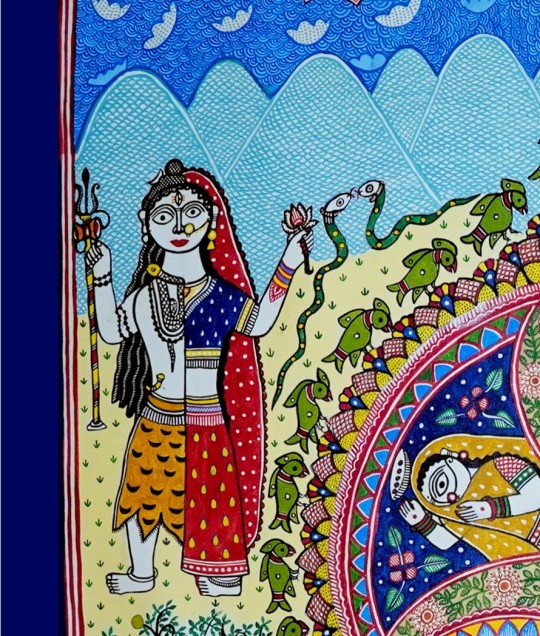
“the Lord who is also a female”, Shiva and Parvati , the union of male and female in one body. This union is now also that of the bride and groom. They have become one.
Shalini Karn is not the first to use Ardhanarishvara as an attempt to give a religious basis for the equality of male and female in the strongly patriarchal society of Bihar. The artist Shalinee Kumari has long struggled with the same question and has also painted a kohbar with Ardhanarishvara. But Shalini Karn by taking the kohbar outside the confines of the marriage room and into the open air has lightened the weight of tradition. She uses the figure of Ardhanarishvara to support the equality of male and female and thus her emphasis is on the love and joy of marriage and the open future of possibilities promised by her Kohbar, glorious over the land and the infinite blue sky.
Shalini Karn, The Kohbar Resplendent, acrylic on canvas, 7x7feet, 2020. The work is signed and is available.
5 notes
·
View notes
Text
The Petrifying Situation of the Indian Media
India ranks so badly for press freedom because much of the media has simply stopped doing its moral job, and, as a culmination of facts, journalism is in some serious trouble in the world’s largest democracy. I’m afraid the consequences could be dire.

A cluster of mics of different channels of India's television media, accountable for shaping the social and political thoughts for the most of the country's population.
March 6, Vinesh Kunhiraman, The Media One anchor, goes on air, just like any other day in the office, about to tell his channel’s five million viewers in Kerala about the death anniversary of a famous comedian and the latest updates on the coronavirus pandemic.
But just a few minutes into the broadcast, he sees the managing editor rushing towards the studio floor gesturing desperately. As soon as Kunhiraman realizes that something’s not right, his image dissolves into a blue screen, a message shows up on the screen saying that there’s no signal and that they regret the inconvenience. The channel’s uplink, all of sudden, goes dead.
Actually, this was no technical difficulty. The channel was cut off as a consequence of order issued by the Union Ministry of Information and Broadcasting to block the channel for 48 hours, because it had covered February’s biggest news story -- mob attacks on anti-CAA protesters and in Muslim-dominant areas of Delhi, which took place just a few days after the result of Delhi’s Assembly Elections, which ultimately flared into a broader unrest and the Delhi Riots -- in a way that seemed “critical towards Delhi Police and R.S.S.,” the order said.
This shows a glimpse of how tolerant the government of world's largest democracy actually is about it’s criticism, despite many of the government ministers and the Prime Minister Modi himself stating that he wants the government to be criticized as it makes a democracy stronger and motivates him to work better.
WIDE URGE TO ADVERTISE “POSITIVE STORIES”

PM Modi addressing the nation amidst the coronavirus pandemic and about the government’s steps to address it.
Just before he announced the world’s largest coronavirus lockdown, PM Modi met with top news executives and urged them to publish “inspiring and positive stories” about the government’s efforts. Then, after the lockdown stranded half a million migrant workers, with some dying along the highways, government lawyers persuaded the Supreme Court to order all media to “publish the official version” of coronavirus developments, although outlets are still allowed to carry independent reporting.
A large section of leading broadcasters were quick to welcome this decision of the apex court, but left many intellectuals with questions on India’s constitutionally guaranteed freedom of speech and freedom of press.
India’s media universe is vast, perhaps the biggest in the world: More than 17,000 newspapers, 100,000 magazines, 178 television news channels and countless websites in dozens of languages. Thousands of Facebook pages call themselves news publishers, and YouTube is filled with local bulletins on everything from real estate trends to police raids.
Under immense pressure from the government, many media owners have fired their journalists who have criticized the PM and his government, and asked their media houses to not to run stories of hate-crime trackers that may embarrass the government or the ruling party. Instead, media houses have been asked to, and have been running what is being called “positive and inspiring” stories so that a “healthy environment” is being maintained throughout the country, and that could actually lead to a number of conclusions from various points of views.
This is so evident at the time of the coronavirus pandemic, where media houses have been given official orders to run the “official versions of the stories so that people do not panic”. Indian media has been constantly pressing on to project the fact the fact how India have been tackling the coronavirus pandemic outbreak way better than the much developed western countries, but not many compared, what we should call, the “other statistics” -- the amount of daily covid tests conducted, and its comparison with the same countries it claims to be performing better from.
Media, being the fourth pillar in any democracy, is morally obliged to present the facts in the way they should, in order to be in the best interest of the people as a whole. Even the academic study of journalism has part where it teaches the students, or the future journalists, to see government’s policies and steps with suspicion, as if media starts supporting government everywhere in any democracy, things could turn out to be disastrous, yes of course it is evident.
They can only ask PM about how much does he sleep, from where does he get the motivation, how much of a fakir he is. And this is the same person who left an interview with just three minutes into it because he was being asked bitter questions about his role during the 2002 Gujarat Riots, Modi was being interviewed by Karan Thapar then, and has not given any such bitter interview ever since even after becoming the Prime Minister of India, and has not even indulged in any press conferences but one, that too just before the 2019 Lok Sabha Polls, in which he did not answer a single question, in fact, gestured many to Amit Shah to answer.
Instead, days before 2019 Lok Sabha elections, PM Modi gave an "non-political" interview to a Bollywood actor, Akshay Kumar, in which he was asked questions like "how does he have his mangoes".
STRATEGICALLY CONTROLLING THE COUNTRY’S THOUGHT PROCESS
It is a fact, even is a part of academic structures in schools, that Adolf Hitler ran a hate propaganda against the Jews for his political gains, most probably fulfilled his personal desires too through it, and eventually built such a large campaign that he was able to convince millions of Germans that a clear minority population composition of 6 million Jews were a threat to Germany and it’s integrity, and that to eradicate and eliminate them by killing them in large numbers and fleeing them was the only possible way to save Germany.
At first, this sounds outlandish for any democracy, as to solve differences between communities, especially by the side of government, rather sounds pretty un-democratic. But the fact that Hitler was able to convince this as only possible way out is very intriguing, as he off course had a popular public support. How was he able to do that?

Adolf Hitler addressing the people in a rally
In Hitler’s Nazi Germany, media was censored by the government, as a result of which what the media can open as news in public domain was solely controlled by the Hitler’s government, which led to media only praising Hitler as Germany’s Savior and projected every person who criticized Hitler as a traitor, giving Hitler complete power to prove so, and execute him. The whole anti-Jewish sentiment was a result of years of propaganda run by the Hitler’s media to earn a wide public support to execute his dangerous plans and unleash havoc.
Seems familiar? A considerable section of the world society sees the same signs repeating in India based on religious grounds. Starting from near-end of 2014, India’s media has run a large scale propaganda based on religious grounds, resulting in instilling of hatred against the largest religious minority in India, and convincing people that they do not belong here. As a result, India has seen a sudden upsurge in mob lynchings based on communal lines, a strong hostility against sections of society, challenging the integral character of India’s Unity in Diversity and it’s very traditional secular character.
CAPTURING THE STILL “FREE VOICES”
The current NDA government and PM Modi are backed up by an army of online allies who discredit and harass independent journalists; female journalists, in particular, have been besieged with abuse and rape threats. And the police say Hindu nationalists were behind the 2017 murder of Gauri Lankesh, a female newspaper editor hailed as one of India’s most crusading journalists.
And for the most part, Indian news outlets have knuckled under, concluding that since much of the public supports the prime minister, they should, too. Even skeptical journalists censor themselves, afraid to be branded anti-national by a government that equates patriotism with support for PM Modi.
The Modi government has been particularly concerned about broadcast media, which reach into every corner of the country. In such a scenario, months before 2019 elections, an ABP journalist, named Punya Prasun Bajpai, questioned the results of government’s scheme of providing financial help to farmers, and broadcasters stated that the broadcast of the show was being interrupted in various parts of the country until the ABP journalist was being asked to leave days after the incident.
There are numerous such examples of journalists and reporters being left out and asked to leave by the broadcasters, so that they’re not being branded as anti-nationals, or lose sponsors or afraid that cases might be filed against them.

Arnab Goswami, from the Republic, hosting his debate program
Arnab Goswami of the Republic TV has come out be one of the most prominent Right wing, pro-government journalist in recent times, with constant praises for PM Modi, his government and his policies and of course his ideologies, and has constantly questioned the opposition for every misdeed in the country. He accused the Congress and Sonia Gandhi of sending goons to attack him in April.
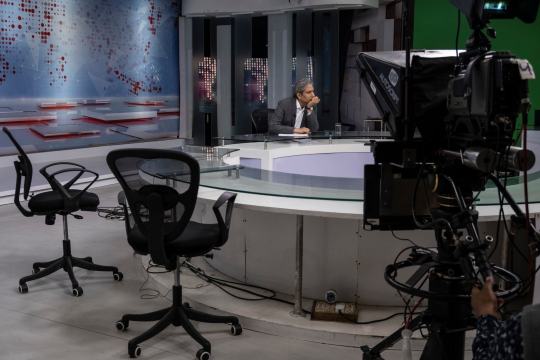
Ravish Kumar, NDTV, in between his daily debate program
Ravish Kumar of NDTV, another popular journalist, this time one who has been critical of government, not only during the NDA tenure, but a hard critical of UPA government too. Being a hard critical of PM Modi and Amit Shah, he has been abused constantly on social media and death threats for him and his family, and the Modi and Shah’s BJP has now boycotted Ravish for years, by not sending any spokesperson in his show.
PM Modi, after taking over the PMO, gave his very first interview to Arnab Goswami, and Arnab has been backing up with frequent interviews of PM Modi, and his senior ministers.
Ravish won the Ramon Magsaysay Award, also known as Asia’s Nobel, in 2019. Even after this, no other channel even covered this achievement of Indian media. Many speculated that had Goswami win the Ramon Magsaysay, would PM Modi, or any of the senior ministers or his senior party members have congratulated him, or tweeted the same? Because not a thing even close to this happened.
THE CURRENT MILIEU

An usual Production Control Room of a news channel, responsible for working behind what we see on air
It is very much evident that the Indian Media is in a state of crisis, it simply ‘cannot speak the truth to the power’. From not being vocal about about how big a blundering failure the 2016 demonetization was and the dent it hit on the economy, to constantly attacking the opposition rather than questioning the power, to reporting from the AC studios and not about the situation from the ground, to initially having ignored the migrant laborer's crisis and much more, all this suggests that from the view of the best interests of a tolerant democratic nation, Indian Media has had been in a deep state of crisis.
If it had not been the case, no journalist in any democracy, can openly criticize the voters on live television of being freeloaders, anti-national and being abused for not electing those in central government in a state assembly election, and walk free without even a complaint. Sudhir Choudhury of Zee Media did the very same back in February after the results of the Delhi State Assembly elections, having called a democratically elected Chief Minister as a terrorist.
No wonder why India has further slipped in the latest Press Freedom Index Rankings to 142nd Rank out of a total of 180 countries, very close to Pakistan, ranked 145th, the only comparison most of the Indian Media understands.
If ever our future generations are allowed to look back upon how India lived in the hallucination of being in its best of times what actually also could be a very strong contender of being one of the most dark times in the history of Independent India along with the 1975 Emergency, Indian Media of the current times would also have to bear a lot of credit for the same, along with many strong names both in the government, and the government institutions.
Information and Pictures’ Reference -
The New York Times
Al Jazeera
Google
#india#politics#news#cnn#bbc#ndtv#new york times#al jazeera#india today#ravish kumar#rajdeep sardesai#punya prasun bajpai#modi#amit shah#indian government#indian media#media#bjp#inc#aap#yogendra yadav#kapil sibal#jim acosta
13 notes
·
View notes
Text
676
Themed surveys are the shit y’all. There should definitely be more of these.
General
Where is your country? My country is in Asia – specifically in Southeast Asia, which I recently learned a lot of people outside Asia aren’t aware of. We’re situated just right below China and we neighbor Brunei, Malaysia, and Indonesia. How big is your country? It’s moderately large, but when you consider how many we are, we are an extremely small country. What is the population of your country? 109 million. I’m not sure if this is still updated, but we’re around the 12th most populated country in the world. Compare that with how we’re only the 77th in terms of size. How would you describe the landscape? We are an archipelago, which means our country is essentially a collection of thousands of little islands – 7,107 in total. Side note: this means it’s always been extremely hard to make an attempt to be ‘united’ as a nation, due to the fact that we are literally separated from one another. But besides that, yeah we’re made up of a lot of islands which means going from one province to another typically requires you to travel via plane, boat, or ferry. Aside from the tiny islands that we have, our country has three main islands, of which the small ones are a part of – Luzon (which is where Manila is and where I live), Visayas, and Mindanao. The Philippines is also part of the Pacific Ring of Fire, which means we have a number of active volcanoes and that we are prone to hurricanes – and we do get them, badly, every year. We also have a number of mountain ranges consisting mostly of tropical rainforests; these ranges, while beautiful, make traveling from province to province quite a challenge. Which part of your country do most people live in? Oh Manila, without a doubt. Most people, especially from the provinces, want to move to Manila because it’s the economic hub and everyone has an ideal image of it bearing opportunity for them. Unfortunately it is never what it seems and Manila is instead filled with the urban poor, some homeless and some living in shanties or illegal settlements. A lot also live in the cities surrounding Manila in a region we call Metro Manila (or, officially, the National Capital Region) to have closer access to Manila, and also because these cities have proven to give them a better life as well.
Tell me about the main industries there. The main economy is agriculture, but since then we’ve been making a shift to manufacturing and the service industries. While the shift looks good on paper, it has since meant that our farmers have been neglected and they remain extremely poor despite the effort they put into their work. Our biggest exports are sugar, coconuts, rice, bananas I think?, pineapples, and mangoes. Tourism is also an important industry and unfortunately we’ve been hit hard by the coronavirus. Nevertheless, significant tourist spots include Boracay, Puerto Galera, Palawan, Siargao, Baler, Vigan, La Union, and Baguio. Lastly – while it’s not an ‘industry’ per se, millions upon millions of Filipinos also try their luck abroad as OFWs (Overseas Filipino Workers) for better opportunity and higher pay. As a result, their remittances to the country is one of the biggest things that contribute to our economy every year, because these OFWs are usually the breadwinners and thus send money to their families, which obviously end up pouring into the national economy. What agricultural products are produced by your country? I’ve already mentioned them, but we’re essentially powerhouses in producing rice, sugar, coconuts, corn, rubber, several fruits such as pineapples and bananas, and a type of material called abaca.
Food and drink
What traditional dishes are served in your country? Which is your favorite? What’s the recipe? We have many, considering PH has a very rich native culture. A lot of our dishes have been inspired by Spanish and Chinese culture, such as lechon (whole roasted pig) and afritada (meat and veggies in tomato sauce) for Spanish cuisine; and siopao (a bread-like dumpling), siomai (our version of Chinese dumplings), and pancit (noodles) for Chinese cuisine. But besides those, we also have come up with our own such as dinuguan (pork blood stew), sisig (chopped pig’s cheek skin, ears, and liver), and sinigang (meat or seafood in sour broth). My personal favorite is kare-kare , which is oxtail and vegetables in peanut sauce. I dunno how to cook it but both my grandmothers have the best recipes.
What drinks is your country famous for? We’re not particularly known for our drinks as much as for our food, but we do have sago’t gulaman and taho. Fruit shakes are also widely popular, and so is coconut juice. We also produce several variants of coffee, such as barako and arabica.
What alcoholic drinks are produced in your country?Again, not really internationally renowned for drinks but Filipinos LOVE their beer. Popular favorites include San Miguel Pale Pilsen, San Mig Light, and Red Horse. Tuba and lambanog are notable local alcoholic drinks but tbh they’re so native and mostly consumed in the province that as a city girl, I don’t even know what they’re made of, and I mostly read of them in books lmao.
Are there any stories behind traditional foods? Not really. But essentially, Filipinos have historically lived in the wild, with some provinces more remote than others; and a lot of people are generally poor. That means it’s in our blood to have to make do with what we have, which is why a lot of our dishes are composed of things that may be conceived as weird by others, such as duck embryo, chicken intestines, or pig’s cheeks. We’re not ‘uncultured’ or ‘disgusting,’ we’re only from a different culture with very different origins than that of the West.
Political
What is the political system in your country? I just know we live in a democracy, but the official system name for our government is apparently a unitary presidential constitutional republic; thanks, Wikipedia.
Who is in power at the moment? Unfortunately we currently have a garbage of a President, and an internationally notorious one at that – Rodrigo Duterte.
How is your country dealing with the current financial crisis? I honestly don’t know how to answer this. The Philippines has never been one of the top dogs when it comes to global economy, and as far as I know we’ve always played it safe when it comes to this, so we don’t really get seriously hit when financial crises happen.
What can you say about the leaders of your country? Miserable. Most of our senators did not deserve a seat, but there they are. As it stands, we have a TV host, a boxer (Manny Pacquiao, no less), a former police chief, and an actor in the Senate. A number of personalities in the entertainment industry have also found careers in politics. This means a lot of the things that are urgent and need lots of rational decision-making are always handled poorly and haphazardly. A lot of politicians are known to be corrupt, stealing millions of money and spending more than they earn – but they always get away with it, the ones who are supposed to be the watchdogs of corruption are also their allies. The genuinely good politicians are always overpowered, silenced, arrested, killed, ostracized – and lose elections.
The elections system is just as sad. Most, if not all, candidates, appeal to emotion and literally exploit the poor by using them as talent in their commercials to show the other poor people watching TV that they are on their side – and because the poor don’t have access to education and don’t know any better, they end up voting for them, even though these candidates don’t actually give a single fuck about the poor. Many spend hundreds upon millions for TV and radio ads for 30-second spots. Election violence, vote buying, and ghost voting are widespread.
Cities
How would you describe the capital city and any other main cities? Manila is a sad shell of what it used to be. Look up photos of Manila in the 50s and 60s, and you’d see it looks no different than the streets of Los Angeles or New York. Today it’s neglected, overpopulated, congested, and resided by people who were once filled with hopes and dreams about Manila. There’s a side of Manila that is beautiful and pretty wealthy – the part along Manila Bay – but this side is only riddled with Chinese businessmen, most of whom treat Filipinos like shit. Quezon City, Makati, and Ortigas are the economic and financial hubs surrounding Manila and for the most part these cities are known as the hip places and it’s where the youth and adults hang out. It’s where the malls, bars, restaurants are, and these cities are the ones shrouded in Western influence; but because people do flock to these places, the cost of living is extremely high from parking fees to condominiums. The major city in Visayas is Cebu and in Mindanao, Davao; but given that I’ve only been to Cebu once, and Davao never, I can’t say much about them. What special attractions can be found in each city? Manila has Rizal Park and tons of museums but the city itself isn’t a favorite among foreign tourists; these people usually go to our beaches like Boracay and Palawan, or the cities that offer a more local scenery, like Baler, Bohol, and Ilocos.
Sports and games
What is the most popular sport in your country? How do you play it? Basketball, FOR SURE. Every barangay or municipality has their own basketball court – literally. Filipinos are just basically obsessed with it whether it’s the NBA, the PBA, or basketball even at the collegiate level. Are there any sports or games unique to your country? Very few. We’ve mostly gotten eaten up by Western culture and patronize sports such as basketball, boxing, and volleyball. The only traditional sport I know of is arnis, which even I know very little about except for the fact that it’s a martial art that involves sticks. When is the best time to watch them? I’ve never watched a game of arnis. And I generally don’t watch sports, so I’m not the best person to answer this lmao. How well does your country do in international competitions? I don’t follow a lot but we’ve made our mark here and there. Obviously Manny Pacquiao is a boxing legend, but we also have Hidilyn Diaz for weightlifting, Efren Reyes for billiards, Paeng Nepomuceno for bowling, Carlos Yulo for gymnastics, and Lydia de Vega for track. Are there any sports that foreign visitors practice in your country? I don’t think so. Is football (soccer) popular in your country? If so, which are the best teams? Not really.
Weather
Is the weather very different in different parts of the country? No. It’s mainly tropical, with extremely humid summers and it’s moderately cold by the end of the year. Only cities with high elevation, like Baguio and Sagada, get EXTREMELY cold during the Ber months, which makes them popular vacation spots during Christmas haha. Sometimes the temperature will dip down to 10 or 9 degrees Celsius, which is a huge deal here.
Can you describe the seasons? We don’t have the conventional ‘seasons’ y’all have. We have two main ones – warm and wet. Wet is just the season with typhoons, warm is either summer, or a period with no typhoons. Pretty straightforward.
What is the best time to visit? It depends on where you’re going. Going to Baguio, for example, is the best during the colder months (October to December) to really maximize the colder weather. Going to the beaches is ideal in April to June.
Language
What languages are spoken in your country? Nearly 200, but official languages are Filipino and English. What language do you usually hear on the streets? Filipino. But it depends where I am, too. In wealthier cities, I’ll hear English more. How many people speak English in your country? A good number; I’d say 60-70% can understand or speak basic English. Those who can speak it conversationally comprise a smaller amount. Some still live in pretty remote areas and thus have no concept of English.
Customs
Is there a particular national costume? Can you describe it? Yeah, for the woman we have baro’t saya, and for the men we have the barong Tagalog. Just Google them lmao.
Are there any special local dances? What are they like? Several ones, like tinikling (a dance where you have your feet play with bamboo poles routinely beat together or tapped by two other people) and cariñosa, a romantic dance. But due to the Western influence here, people are more prone to get into hip-hop or contemporary dance more. Are the people generally friendly? Without a doubt, yes. Filipinos are extremely known for their hospitality. If a tourist were to knock on our door right now we would definitely let him in, make him dinner, and my mom would probably ask me to give my bedroom to him for the night. What are some special customs or traditions in your country?
We have the mano po, which is when younger individuals would greet their seniors/superiors by taking the older person’s right hand with their right hand, and placing the back of the older person’s right hand it onto their forehead. It’s a significant sign of respect and to avoid doing it is extremely impolite.
We also have the concept of community spirit, or bayanihan. Basically, if one is in need, everyone in the same community steps up and helps. The quinetessential example for this is when one has to move their hut to a new location (Filipinos before were nomadic), all the neighbors swoop in to help lift the hut and carry it all the way to the new place.
Courtship was an important step in traditional society, and the man would do a harana, or serenade the woman while playing the guitar, in front of her house while she looks out her window.
Noche Buena is the traditional midnight meal (kinda like our version of Thanksgiving) that we have by the end of Christmas Eve to usher in Christmas Day
Po and opo are filler words used to denote respect, and is always affixed to the end of sentences when speaking with elders. It’s not required, but of course you’ll look like a disrespectful asshole if you don’t use it with older people.
History
What can you tell me about the history of your country?
Pre-colonial Philippines was rich and vibrant, and one that would be considered pretty fucking progressive even today – transgender people were welcome, women were of a higher social status than men, among others.
This all changed when the Spaniards came and tl;dr ruined everything for us. They wiped out our folk religions, literature, songs, legends, epics, and everything good that we had going. Friars abused us physically, sexually, and economically; everyone was forced to convert to Catholicism; early newspapers were shut down; forced labor was imposed; anyone who disagreed with their rule was killed.
After 333 years we were sold to the US for $20 million. Americans gave us the modern education system, a modern government system, a richer literature, religious freedom, and of course, the English language. But they also brought us colonial mentality and materialism, which persists to this day. Americans were also racist towards us and the only reason we have international schools today is because these were actually started up by American soldiers so that their’ kids would have schools that didn’t have native Filipinos in them.
By WWII, Japan destroyed the Philippines, leaving us to start from scratch. They bombed Manila, raped our women and young girls and made them sex slaves, brutally murdered everybody else who weren’t women and young girls, stole everything from us, and established a puppet government in Manila to bully us further. The only reason they gave us independence was because US had dropped atomic bombs onto Hiroshima and Nagasaki, and they had no choice but to surrender.
Three colonizers has left us pretty traumatized, something we’ve never truly recovered from to this day. Our political system is shaky, our sense of identity is lost, we’ve never been truly ‘united’ as a nation, and the Catholic penetration has made us a widely conservative, pro-life, anti-LGBT country.
Did your country gain independence from another country? If so, when and how did this happen? See above.
#survey#surveys#bruh i feel like i just wrote a research paper#I TOOK 3 HOURS ANSWERING THIS#but it was very fun
2 notes
·
View notes
Text
My Criticism of Planet Puto
You know, just in case HC never finds about my criticism...
“Hello HC! My original criticism was lost…unfortunately but I`m determined to get my message to you. I wrote it on Word first before posting it in your submit. If you managed to get my old submission, then I`m glad that it worked, but if it didn`t then that`s why I have this. So HC, I wanted to do this for a long time but I needed to be composed of my thoughts first. Now I`m ready.
In this submission, I want to talk about the character development of your personification characters and character design. I`ll also talk a little bit of the lore by the end of the post. It is not intended for hate, it is just criticism. I am also aware that Planet Puto is more like random posts instead of comics or something. The reason I feel like giving criticism is for HC`s improvement in some stuff and to voice my concerns. Before I write my criticism, I would like to praise HC for her/his dedication to creating that group of Actor AU (I don`t know their names but it`s the Aswang lady and her Spanish-y husband and they had twins). I love your work since it has good art but mostly it`s because you post so often. Reading your posts become a part of my everyday routine.
So before we get to the specific criticism and tips, I`ll talk about my general problems with the personification characters. It appears to be, that the characters are used for meaningless fanservice. When I`m scrolling through the Planet Puto archives, once in a while I will see characters drawn with sexy poses or they have ship tease with someone. If it is part of their character, then that would make sense. So is everybody…smutty? It seems like whenever there is a major foreign country, they would be shipped with Elena or Emilio. There are entire pages filled with random pick-up lines from Emilio and all the art of Elena with the guys.
I`m not saying that shipping is bad. I think it is perfectly fine for some countries to be attracted to Emilio or Elena. What I don`t understand is…why? Why do those countries find Emilio or Elena attractive? What do they see in them? Please don`t say, that they love the Phils because Emilio is pogi and Elena is maganda. If that is the reason, why they love those twins, then that is not real love at all. Also…they can`t just be compatible because of politics! It is like shipping someone with another person just because they had a good business deal. It also makes me wonder if a country can even decide who to love instead of who they are told to by their bosses. It`s sad no?
It would be best that you create the character before the ship. If you create the ship before the character, they may end up not being their own person. Also pair the ones, who are naturally compatible. It`s like food combos, there are basics like cheese and tomato go so well but when you experiment you will also find out that green mango tastes great with bagoong. Relationships, like food combinations, should be compatible. When people talk about food combos, you hear “The tomato`s freshness balances out the saltiness of salted egg” or “A bit of chili actually brings out the flavor of vinegar”, so characters should be like “He has a great mind but sometimes he can be really tough. She quite emotional but she can be the best friend you can ever have. Together, his heart softens and he learns how to get along with other people. She learns how to keep cool and keep things together now.” Characters by themselves are great, like peanut butter bread and jelly bread, but when you put them together, they are even better.
Be careful of red flags! If the relationship is starting to break boundaries, border on abuse, and toxic behaviors, please stop. It will just give the wrong message to the audience if you ship something like that. After all, in a food combo, if one of the ingredients are rotten it would make you sick. The pair should not be toxic to each other. You can still portray abusive relationships, but please don`t romanticize or encourage it because it`s not okay. It will never be okay.
You must develop them first, though. After you got their character, then you can start thinking about shipping. They must care about each other. That is the bare minimum for a good ship. In psychology, people are more likely to be attracted to someone they have in common with but not too much in common. The thing they have in common could be anything like background, motivation, interests, etc… After that, be careful not to make them too similar or too different. To add special garnish, if the work has a theme, then it would be best if that ship reflects opposite or different sides of the theme. That would make everything really juicy. Remember to not force it, if they can`t match no matter how hard you try, then they weren`t meant to be. Move on. The best ships will just come into place.
Summary for writing ships:
-They must care for each other
-It must be natural
-They must have something in common but different enough
-Experiment
-Avoid Red Flags
My other general problem is random sadness. I`m okay with sadness, but the sadness in Planet Puto is very random. Everything is happy then boom! Sadness. I don`t understand what it is supposed to mean, what am I supposed to know here? There is a pattern of using historical events for angst. It would be much better if the angst was more built up and more meaningful if the characters had character.
Let`s start with the protagonist, Emilio. Of all of the characters, he is the one I have problems with the most. I find it hard to discern a characteristic to him other than a pabebe, a flirt, and a pushover. I`m sorry if that is insulting, but that is my own impression. He may not be like that, but the way he is portrayed gave me that vibes. So what makes a protagonist likable and memorable? They should:
Struggle: Hmm…does Emilio struggle? I have been searching all the pages with Emilio in them to know. None of those posts indicate really big things. I try to dig deeper like a Language Teacher but it is hard for me to see the meaningful struggle. All I see is meaningless angst. The problems that Emilio faces are politics, love life, and history. Politics, I understand that it is hard to live with such a corrupt government. What I need to know is…how does this affect Emilio personally? Normally, citizens of this country will not feel affected by politics. Sometimes they will be affected, but most of the time they would live most of their lives without worrying about this. It would be best to show how it affects Emilio on a personal level, so I can feel why.
Love life, it is now a more human problem. I wonder why personifications aren`t marrying each other by now. So many feelings and ship tease! Are they forbidden? If that is so, then that would be impractical. There are so many countries in the world, so at least one government permits a country to marry another country. I also wonder why Emilio only dated Brunei. I remember you said it is because of the union of the Kingdom of Tondo and something Brunei. So does that mean, whenever a country is joined by political alliance or merging of kingdoms, are they are automatically in love or dating? Heartbreak happens, it is a human thing but I hope it isn`t too much of a problem. There is such a thing as move on, right?
History, now that could have a lot of potential. I think there is a lot of creative potential with this. The problem is…how do you portray it properly? The best thing to do is to look in history books and determine what he would be doing at a place in time. Give him a backstory based on the things taught in history. I know you are doing that, but I think it is unrealistic that Emilio is everywhere at once. How is he in a lot of historical events!?! There has to be an explanation. I think it could be answered by knowing his occupation exactly. What is his skills? What are his abilities? Does he have powers to help out? What does being a personification mean? These things could really help me understand how the plot works.
(Out of topic: What is being a personification? How immortal is he? What if we cut off a personification`s head? Would they die? What if we chopped off their fingers? Would they be crippled or would their limbs grow back eventually? In your WWII drawing, Elena asks Japan to finish off her useless brother, so are you saying he can die? What if no one saved Emilio?
Do personifications get paid for being personifications? Can they resign? Do they have insurance or vacation days? Do they get a bonus? Do they get senior citizen`s discount, after all, they are older than our grandparents? Why do countries have a girl and boy version? Let`s say Emilio resigns from being Phil, would Elena have another twin?
What jobs do personifications do? Are they immediately conscripted to be a soldier, kind of Captain America? Captain America is a super soldier and also used for propaganda. Do they go in missions assigned to them by their presidents? I remember your Brunei and Phil post, that countries might be super spies by their governments. Is it really something like that? Are countries allowed to have other jobs? I remembered a post, I asked if personifications can have jobs. Emilio answered that he wanted to be a general, so he is not allowed to? He is the amang bayan after all, can he use his influence to get the job that he dreams of. Why can`t he be a general? I also heard your answer that being a personification means that you help people, how do they help people? Do they work in social services? Military? Education? Counseling? Psychology? NGO?
Can they have superpowers or are they as strong as an average person?
PLEASE ANSWER THIS, EVEN IF IT TAKES TIME. I CAN WAIT. You don`t have to make a drawing for it. Just type or draw if you like, I just really need to know. What if you randomly gave the characters abilities out of thin air? That would be really confusing. You might risk yourself with plot holes. We would be left out with the information needed to know what their life is like. If they have more detail what is their job exactly, then I would feel like they are more relatable because they actually have a life of their own other than being a mascot.)
Not whine: Back to one of the general problems, random sadness. Emilio is the one with the most random sad posts, so he has that main problem. I don`t know about you but if you put it in real life. It would sound like whining (I`m sorry). What is whining? It is a negative connotation of complaint. Complain is to express grief, pain, or discontent. It is okay to show strong emotion possibly even required but it would be weird to hugot it a lot.
I already talked about the struggle part, not whining is the combo for struggle. Why? When someone suffers and they whine, suffer, whine, suffer, then more whining, then it would feel like handling an annoying baby. I know that they have pain but I would not respect them if they whine. They would be just like an average person to me, “That sucks, but the way you reacted made me not like you.”
Struggle makes the audience root out for the protagonist because it is natural human behavior to root out for the underdogs and struggle is what everyone goes through so it`s relatable. Not whining is what makes the protagonist respectable. Who has more virtue, a person that complains whenever there is something inconvenient vs someone who endures it instead?
A protagonist should be relatable hence, struggle, but they should also have something admirable because if they are so painstakingly average it is not any more interesting. We did not ask for reality to be displayed, we already live with that every day. What we want is to be entertained, learn, or feel something. A protagonist is someone we should admire, respect, and relate to.
In my opinion, Emilio in the Yandere!Adam event actually shows a bit of character and for the first time, I find myself surprised to actually care about a fictional character even if it is a little bit. What I am talking about, are the normal posts before that.
Be active: This is what makes an ordinary protagonist, entertaining. An active protagonist is a protagonist that shapes the plot while a passive protagonist is pushed by the plot. Why I believe that Emilio, isn`t an active protagonist, he is controlled by events. I have never seen an event that Emilio started because of his actions. For example, Yandere!Adam event, Yandere!Adam is the one that sets the events in motion, while Emilio just watches. I can understand since it is a Yandere!Adam event, it has to focus on Yandere!Adam. I just wish that there is an event of Emilio`s own doing.
(Out of topic: I feel like Emilio and Elena`s relationship isn`t that strong when I looked at the Yandere!Adam event. Letting your own twin die?! It affects me a little bit personally because I have a twin of my own. I would never imagine killing my own twin or letting that happen. According to research, boy-girl twins are even closer than same-sex twins, so they should be closer but they are not. Maybe it is because they were separated for so long, so that is why they aren`t that close.)
So in totality, I think Emilio needs a lot of work in his character.
IN SUMMARY:
-Please elaborate in his struggles
-Tone down the hugot
-Have an event focused on Emilio
-Add more to his backstory
-Tell us more about him
So that is all with Emilio. The other main characters like Elena, Luzon, Visayas, Mindanao, Manila, Cebu, and Davao don`t get enough characterization. They feel like caricatures and stereotypes sometimes. I don`t get who they are supposed to be like. Cebu as INTJ really? As a fan and deep researcher of MBTI, it is hard to see why Cebu will be that. In a nutshell, my impression of them are:
Elena: Oh I`m going to help Emilio, get shipped with so many dudes, and do most of the country work.
Luzon: I`m Miss Serious who is kind of like Manila by design. I`m also the boss and hate insubordination.
Visayas: I`m the guy that has such a peaceful life and brown streak of hair. (Apparently, I also betrayed my countrymen by siding with Spain.)
Mindanao: ….
Manila: I hate probinsyanos! Especially Cebu. I`m swimming in the trash and I have problems…with Cavite. #ampalaya #lifesucks #dacapital
Cebu: I hate Manila! (Hehe I speak Bisaya so he can`t understand) I also don`t get along with Iloilo.
Davao: Yay! (Anime hair).
(Out of topic: I get confused with the glasses on capitals. You said that it was a sign of progress and you put the capitals of other nations with it. It feels quite the opposite. People need glasses to see, so when someone becomes a capital do they become visually impaired? Or they don`t really need it. Does that mean that glasses on capitals are like crowns on royalty? It gets quite confusing to theorize over simple stuff like that. It seems to be too much of a coincidence.)
I`ll talk more about character design later which involves the main characters.
-----------------------------------------------------------------------------------------------------------
While writing this, I realized that foreign personifications were more developed than the main characters. They show more personality in a page than Emilio or Elena can show in 10 pages. For Adam, I thought his character design immediately gave me the vibes of someone who would be America. He tries to keep his reputation so he hides his brown eye with contacts and he hides issues to show that he is strong. When it came to struggling, I feel like that is implied. He seems admirable at some aspect and he sets the story forward as a colonizer.
His character design also gives an implication of his character. He has blonde hair and blue eyes (something that is associated with America), he has a blue business suit, red tie, and white underneath. That is the colors of the American flag! Colors like that are usually associated with heroes. I immediately saw a developed character in him. I wonder why that can`t be the same for Emilio or Elena.
Emilio`s outfit is a Filipino barong, he has sun-kissed brown hair, tan skin, and really, really light brown eyes. He is basically brown all the way through. While Elena has similar eyes, black hair, and light tan skin. Their outfits are traditional Filipino clothing. Luzon has a yellow tie and female business suit. Visayas has a red shirt and brown pants. Mindanao has a white robe with blue highlights. It seems like the island groups are wearing the colors of the Philippine flag.
Their character designs are okay enough. It could possibly do better but it`s okay. When I mean to do better, I think you should modify it a little bit so it can look better. Like add detail to the clothes, use a different shade of color perhaps (the current colors aren`t bad on its own but I think it is best to experiment), and I think that is basically it. I get that you gave them really unusual eyes, to give them an anime feel (Personally I don`t like it, but I would not criticize that. It is your own personal aesthetic decision.). Maybe give Emilio and Elena an alternate casual outfit, the traditional clothing makes them seem like they can`t move on from the past (unless that is what you are going for).
The provinces are what I have a problem with. I can see that you tried, but some of them need work. They look unique but not unique enough. Sorry but, I think they look like branded food from the grocery sometimes. The Mindanaoan personifications are the most unique, Visayan personifications vary in quality but mostly unique, and the Luzones personifications have the most problems. I think you should do a bit more work in Ilocos Region, Cagayan Region, Central Luzon, CALABARZON, MIMAROPA, a bit in Western Visayas, and Zamboanga Peninsula.
Ilocos Region:
Pangasinan. Despite being part of Ilocos Region, he isn`t exactly Ilocano. He is Pangasinense. That means he has a different ethnicity than the rest of his fellow region mates. His economy and some of the way he acts is a bit different from the Ilocos. In all means, he is different from the other members. So he should look a little bit different. His fashion sense isn`t that good either. Come on! That collar shirt looks too long and does nothing to improve the figure. The hair is all levels baduy.
Ilocos Twins. They seem too similar to each other. It seems like the only difference is how they tuck their shirts and belts, and that Ilocos Norte is wearing a fake mustache. The minuscule detail is that Ilocos Norte has his pants tucked in more neatly while Ilocos Sur has slightly loose pants. You can differentiate them a bit unless you like it that way.
In general, they are kind of plain. It would be best to add more variety and fashion sense. (Unless you intended it that way)
Cagayan Region, Zamboanga Peninsula, MIMAROPA, and Western Visayas:
Make them a bit more varied.
Central Luzon:
Pampanga. My DEAR province would never wear something like that! It`s like he didn`t move on from the past. Bro, it is the modern days not revolution. Besides, Pampanga would wear a uniform during that period of time. In reality, Kapampangans like to dress well to the point it is a stereotype. Whenever there is an event or casual life, we always like to dress up. I think it would be best if he has a more fashionable outfit or you add something to the outfit to make it more fashionable. The most fashionable ones always seem to be the Metro Manilenos. It would be good if there are provinces that are really, really fashionable. Fashion is a really big deal.
What feeling are you trying to invoke when you made him?
Bulacan. Really baduy. This outfit is something I imagined to be in a cheap fantasy project. The upturned collar according to historical events was a trend because it was “preppy”, so okay then I guess since it indicates character. The shirt is really plain and does not catch the eye. It feels like it was cheaply done. The color of mint green or light green used for the shirt does not add to his character. Light green is used to indicate the more positive aspects of green like growth or healing. Quite ironic, since his eyes were turned grey due to fireworks.
The outfit is even worse than Pampanga`s, at least Pampanga`s outfit is something that someone would wear but that is something I don`t see in a traditional outfit or normal clothes.
Others. Bataan`s outfit is also baduy as well as Nueva Ecija. Why do the girls always have to wear traditional clothing? What is Zambales ordinary outfit? He does not dive all day, you know.
CALABARZON:
I have fewer problems with these guys but...does Cavite have to always wear the uniform. I`ve seen him in a different outfit before. I wonder what his signature normal outfit would look like. Laguna wearing a baro`t saya…a classic for Planet Puto women. What does Quezon have that is different from QC? They are pretty similar.
GENERAL CHARACTER DESIGN
Character design is of utmost importance because it can determine first impressions and show personality. What I`m looking for in character design is Personality, Color Scheme, and Symbolism. Personality is displayed by the little details like a business suit to indicate the character`s work-like personality or a suspenders to indicate a person`s old-fashioned/gangsta/a cop/compliments the figure of a muscular body. Colors have multiple symbolisms, blue can indicate dependability but can also give a depressing feeling. Light blue has more positive connotations but dark blue indicates the darker aspects. Little things like the wear the clothes are worn can indicate if someone is a slob or a neat person. Clothing can also indicate the standard of living, fashion style, personal preferences, and attitude. After all, you are what you wear.
Of course, character design is not just clothing it could also be a hairstyle, how the body is built, and stuff like gesture can add a push of characterization. Do they wear their hair in a neat manner or they have long hair? Things like that can indicate the beliefs of the person or attitude. Are they muscular? It might indicate that they workout, part of the military, or some physically demanding work. Are they thin? It could indicate that they don`t eat much, but why? See, that adds more character.
IN SUMMARY:
-BE FASHIONABLE (unless it is part of their character not to)
-MAKE THEM STAND OUT
-ASK “Why would they wear this?”
-COLOR IS IMPORTANT (research their meanings)
-COLOR SCHEME IS ALSO IMPORTANT (make it still look good, unless it is part of the character to clash)
Optional:
-Give each character a signature color that fits their personality
-----------------------------------------------------------------------------------------------------------
Thank you for listening to my character design and characterization criticism. The lore is really difficult to get into. The only lore I can theorize perhaps is the Yandere!Adam with his eyes. That is basically it. I want to know where personifications come from, how immortal are they, and their origins. How was Emilio made? Did he have parents? Or he just appeared into existence? How are Elena and Emilio twins? How are they related to Mindanao, Visayas, and Luzon? You know, questions like that.
I`m sorry if I was offensive or anything. I really mean the best.”
6 notes
·
View notes